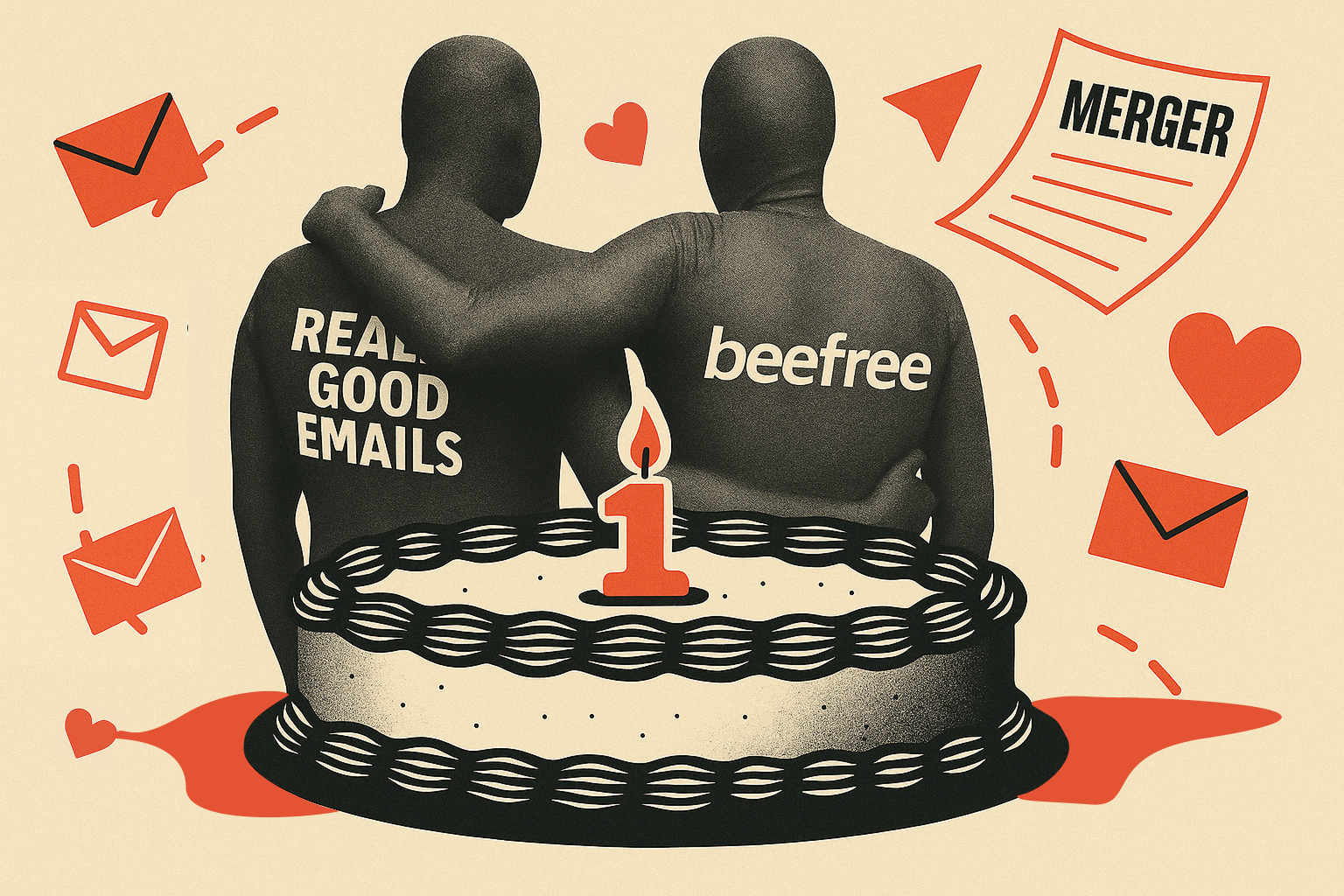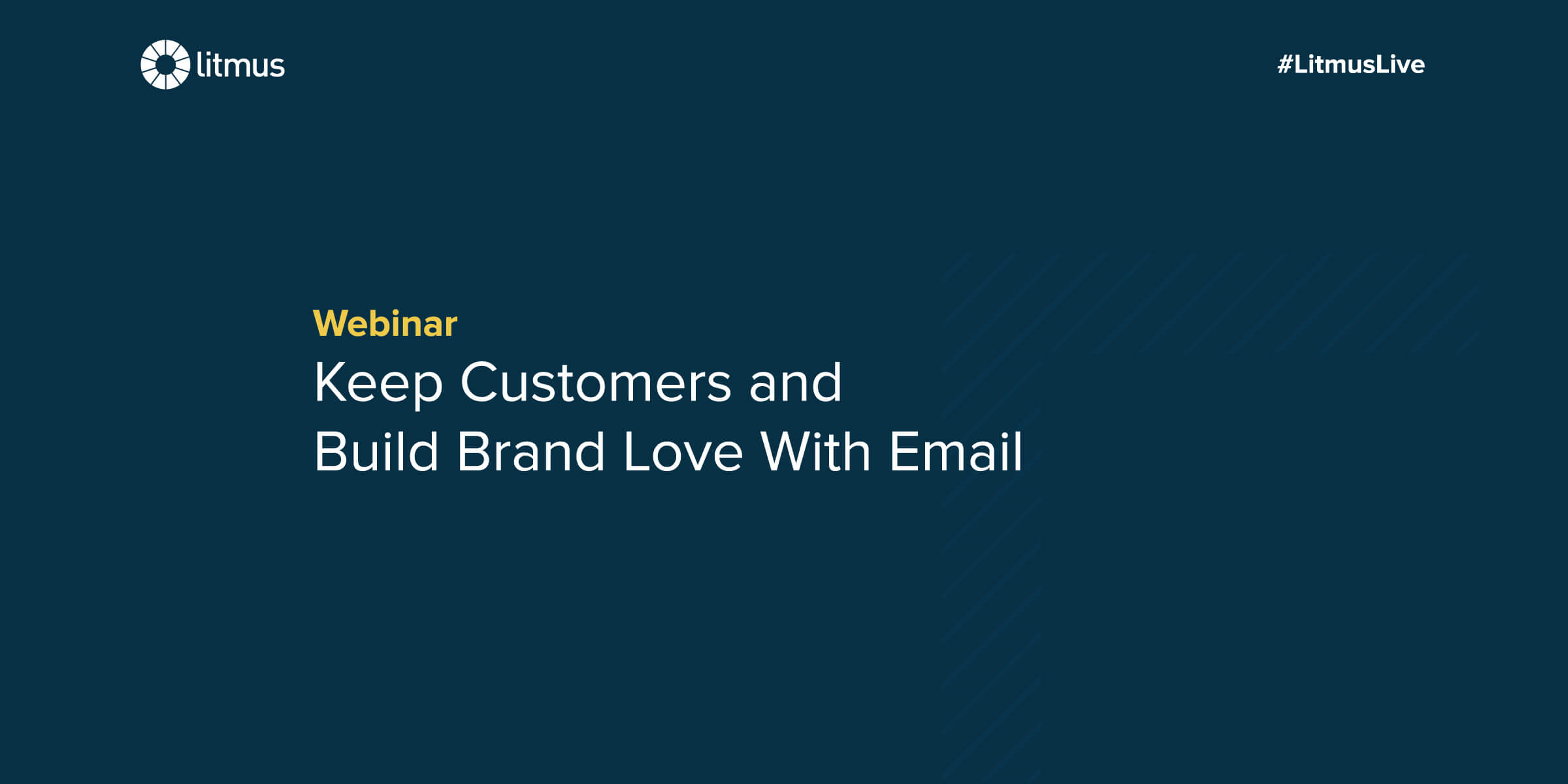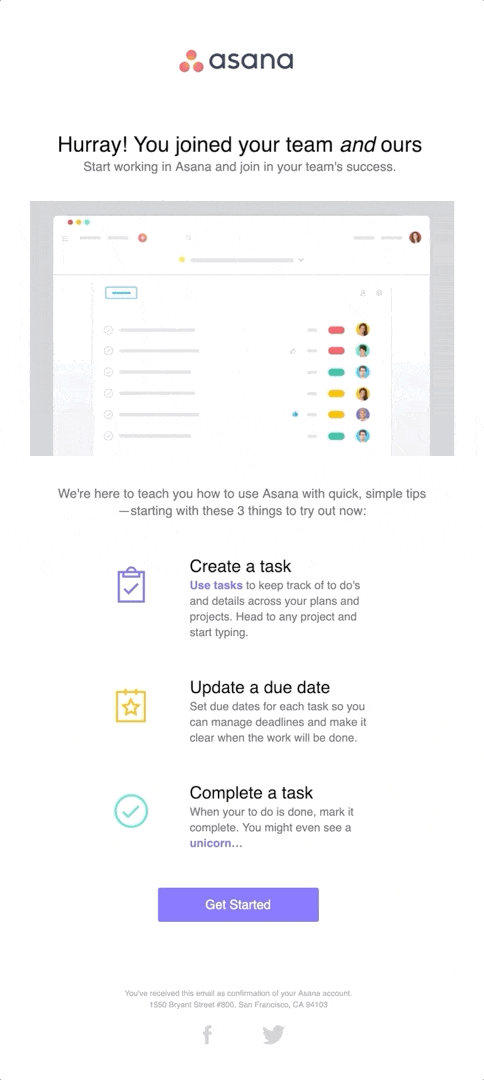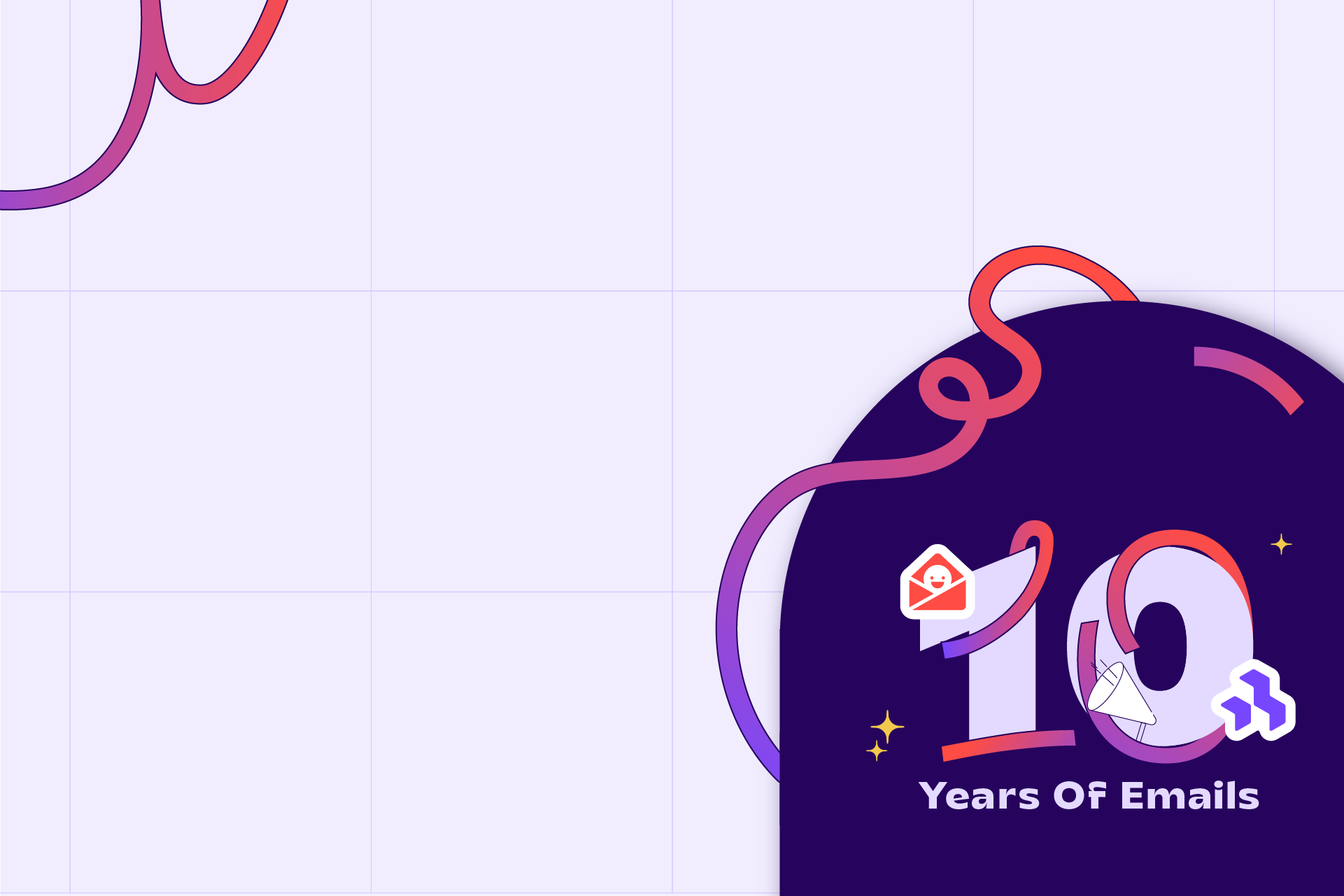I work at Litmus. I'm the community and product evangelists, and you've probably seen me before on all these webinars. I'm joined today by Lyla Val and Mike, which I will let them do their own introductions. Let's start with you Lyla.

Lyla Rozelle: Thanks, Jason, and you are very awesome. Don't sell yourself short. I'm the retention marketing manager here at Litmus. So I'm working on customer marketing, retention, marketing here. If you've got an invite to a customer webinar or anything like that, it's generally coming from me and the email team. So, happy to be here.
Jason Rodriguez: Welcome Val.
Val Geisler: I'm Val Geisler and I am pretty obsessed with retention email. I'm a specialist and consultant to SaaS and subscription-based e-commerce. I love subscription models and talking about keeping customers long term, which just happens to be what we're talking about today. So I'm glad to be here and talk about my favorite thing.
Jason Rodriguez: Awesome. And Mike, a familiar face around these parts.
Mike Nelson: Yeah! Mike here from Really Good Emails. Thanks for having me. If you're unfamiliar with Really Good Emails we are this really weird site that goes out and collects email and categorizes them. So there's lots of emails in this category that we'll hit on today.
Jason Rodriguez: Awesome. So if you're here, you probably know that email is an absurdly valuable marketing channel. At Litmus, we've been hitting on this theme that we like to call email first. That really just tries to remind people that since email's so valuable, it should be your go-to marketing channel for a whole bunch of reasons.

Again, because most businesses see a huge return on investment when they do invest in email. So over the years, we've seen averages range from $38 to $44. And even beyond that for some industries in some companies. So since email is so valuable, it's probably a great place to invest your time and invest your strategy, but it's a great place to experiment with a lot of things too and it has a lot going for it.

It's relatively quick and easy to set up email campaigns to test out different marketing value props, to see what your subscribers, what your customers are responding to. And just see what really resonates with your audience through email first, and then use those learnings to inform a lot of your marketing strategy across all these other different channels.
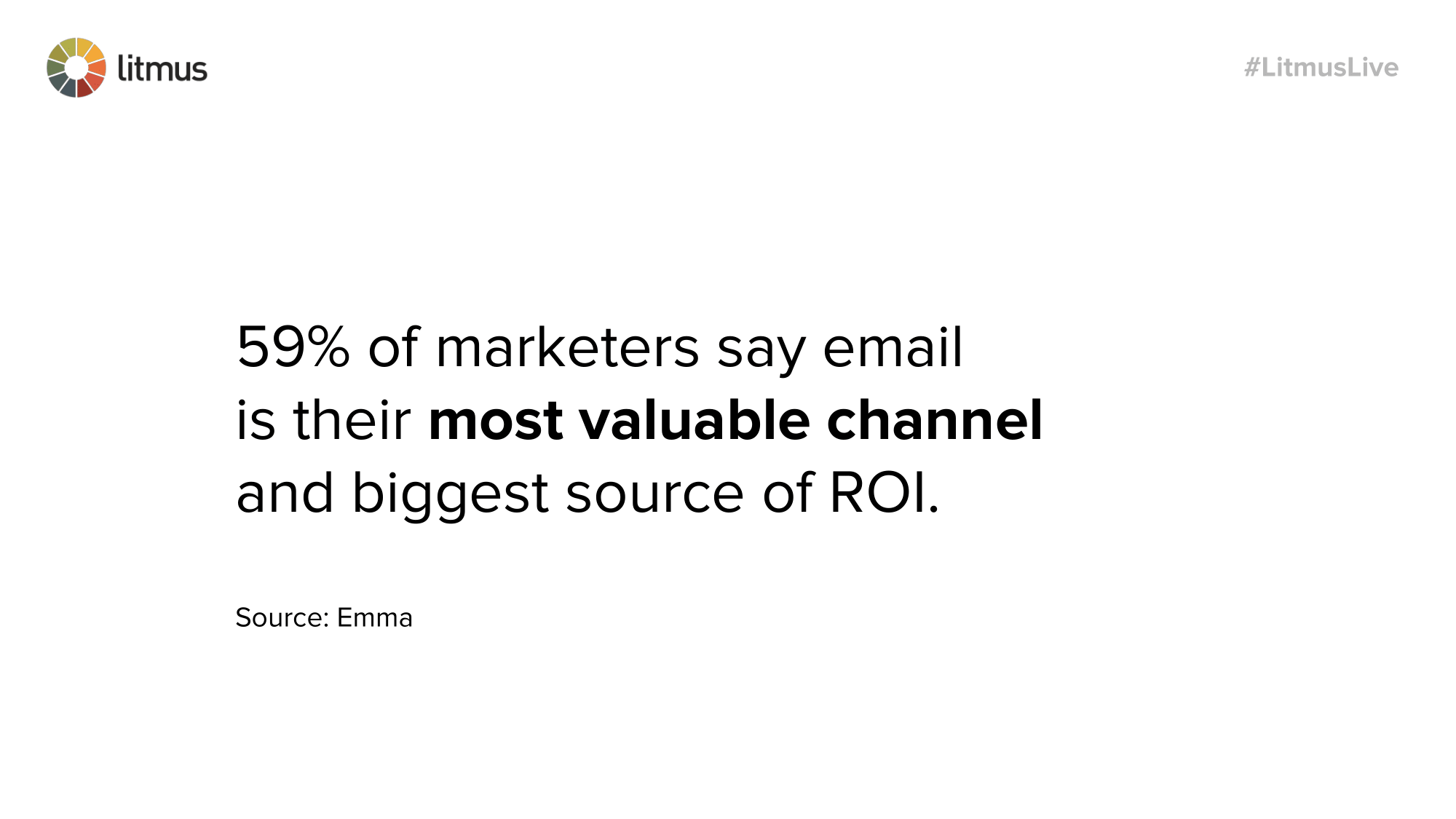
I don't think it's any surprise to anybody here on the webinar that email is a very valuable channel and something that you should probably pay a little bit more attention to. But there's a lot that goes into the email journey and that journey of your customers from signup all the way through to purchasing, to follow-ups. All these kinds of ideal landmarks that we've found throughout the customer journey and email marketing. There's this great kind of idealized path from ConvertKit, which is an ESP, about this ideal customer journey. That first encounter when they opt-in to your email list.
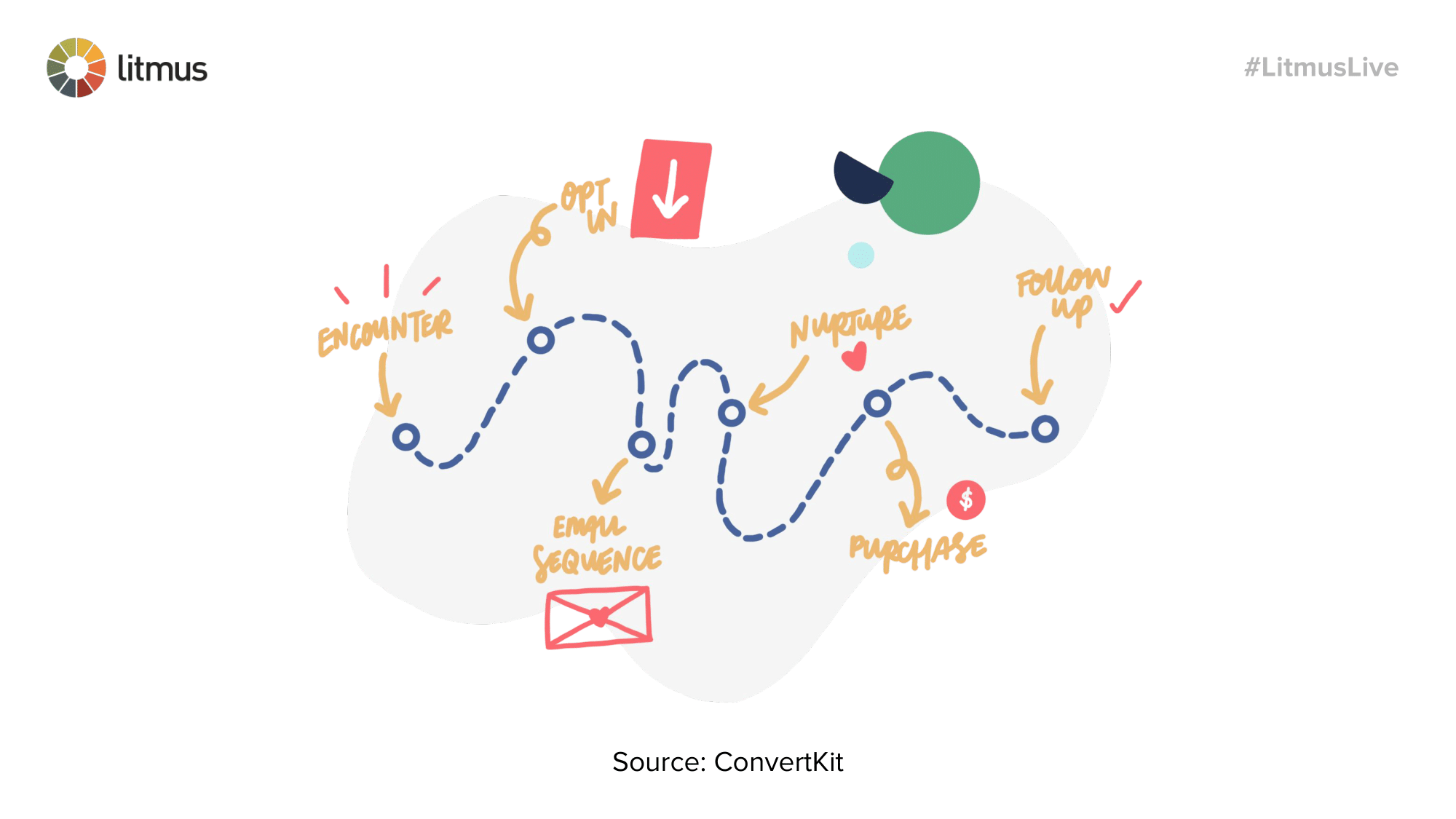
What that ideal welcome email, that onboarding journey, looks like through nurturing your customers and guiding them to their first purchase and multiple purchases after that. But a lot of times that isn't really reflected in our actual customer journeys and our subscriber journeys.
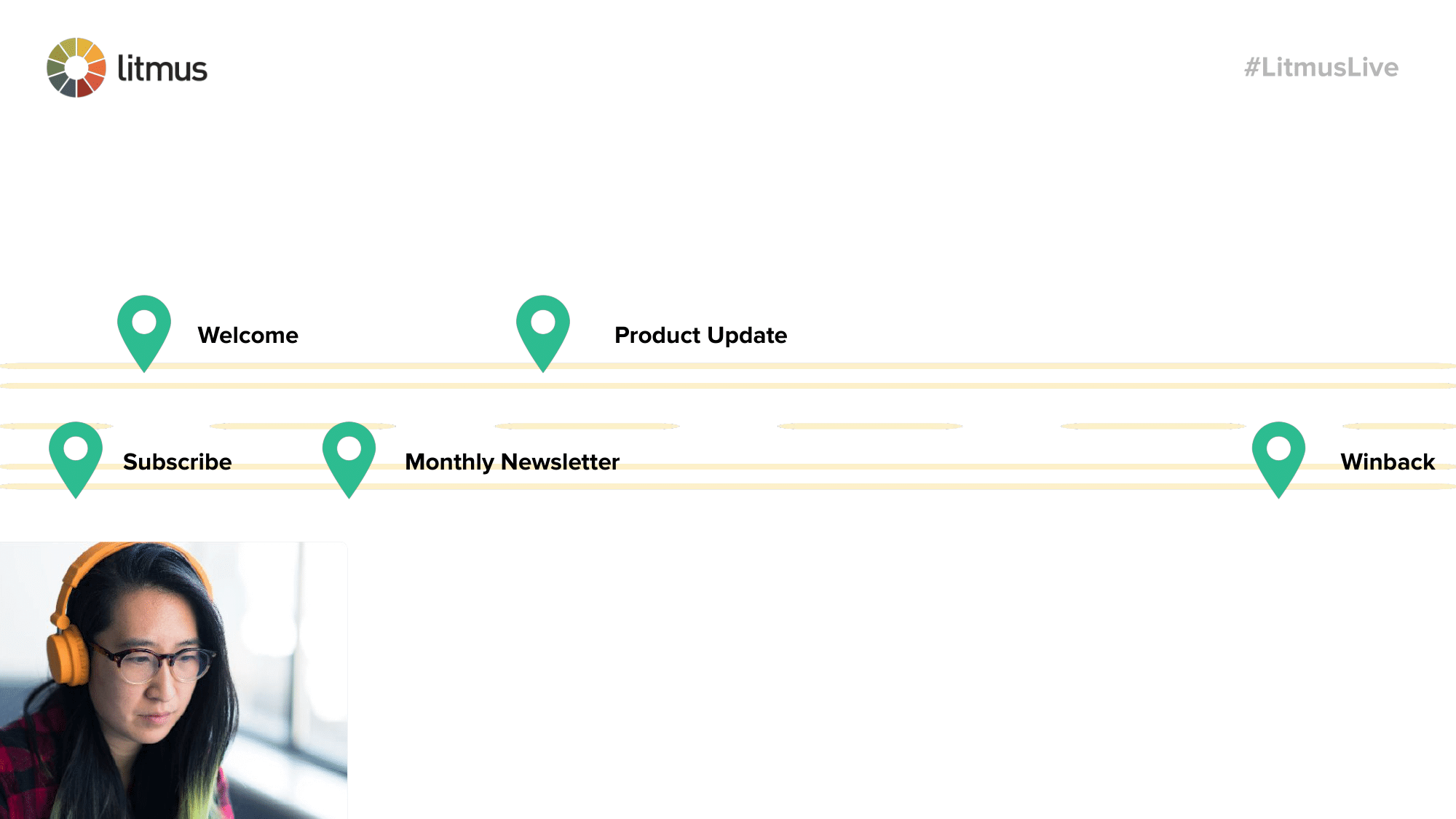
For a lot of people, it looks more something like this, where you have somebody subscribe, you have that quick welcome email. They might get a monthly newsletter. You'll send them product updates as they happen. but there's this really big empty spot in the middle there between those first couple of touchpoints.
Then when you notice that they've lapsed and you need to start winning them back as customers. So we're going to talk about a lot of different aspects of this customer journey and these three phases in this relationship building, from onboarding through long term engagement, and winbacks. We're going to be focusing a lot on that longterm engagement aspect and what Val has spent so much time looking at. Reducing churn and creating that long term retention.
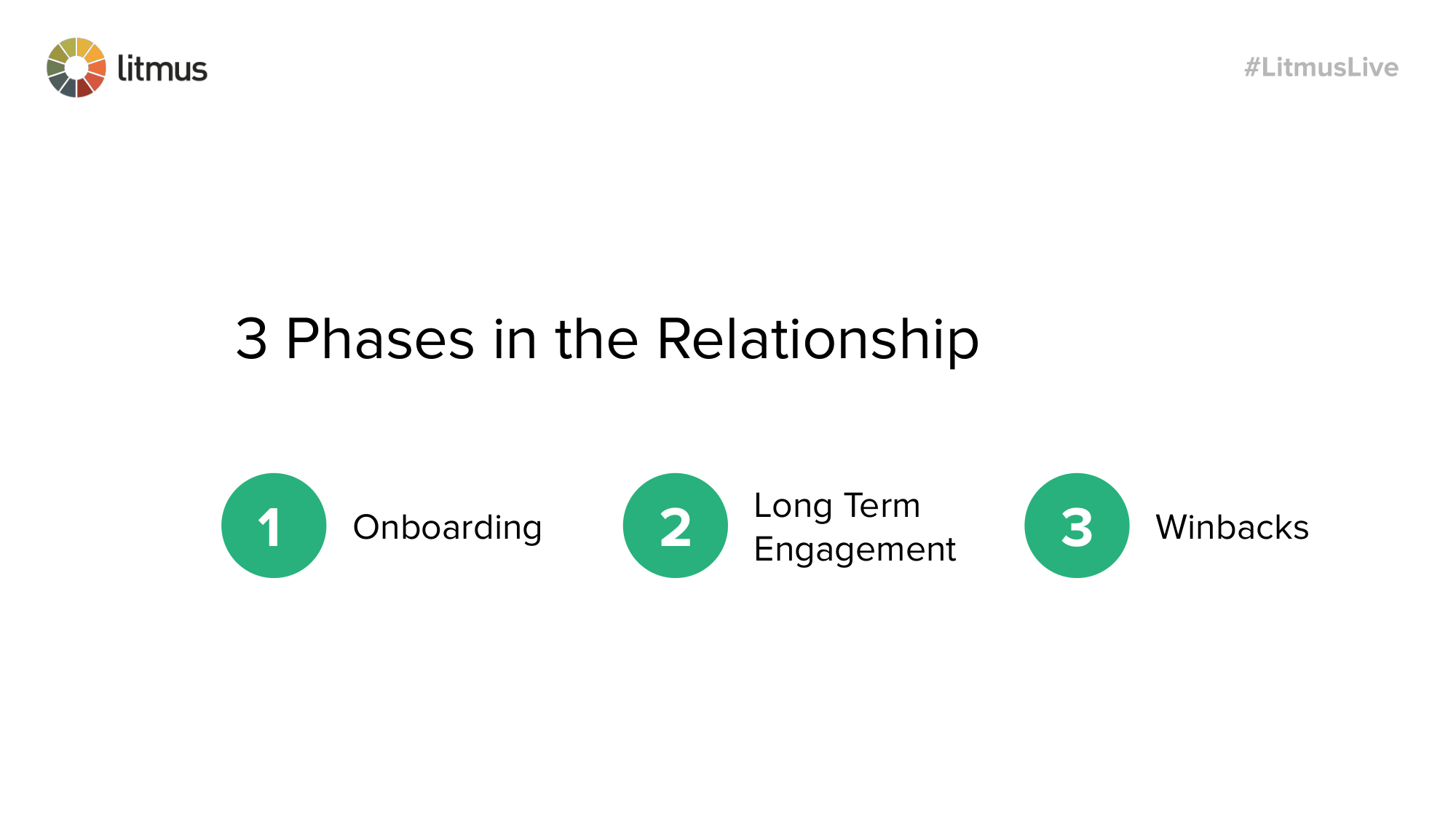
That's the subject of today's webinar. We're going to look at how to successfully onboard your new subscribers and your customers. What those welcome emails should look like. How different companies are really tackling that really effectively. Then we'll really look into how we create that engagement longterm with our subscribers? How do we retain them, even if we're not sending out product updates or monthly newsletters? What does that long term engagement really look like? How can we make sure we're doing that properly so that we keep people interested in our brands and build all that brand love and keep them coming back over time?
Of course, we all have lapsed subscribers. There's nothing we can do to avoid that. It's always going to happen, but there are definitely some things we can do well to make sure that even when they lapse, we can win them back and re-engage them effectively. So that's what we're going to be talking about there.
I'll be moderating things, but I'm going to hand things off to our panelists, starting with Mike to talk about that first phase and that subscriber journey, which is onboarding new subscribers.
Mike Nelson: Thanks, Jason. I'm glad we're doing this today and really want to touch on that point of it being a relationship. When you think about email, email is just one way that you communicate with your followers, your fans, your customers. and these people are actively giving you their information because they want to be contacted. That's how the engagement starts. So you have done something to catch their eye to make sure that there's some reason to get this going.
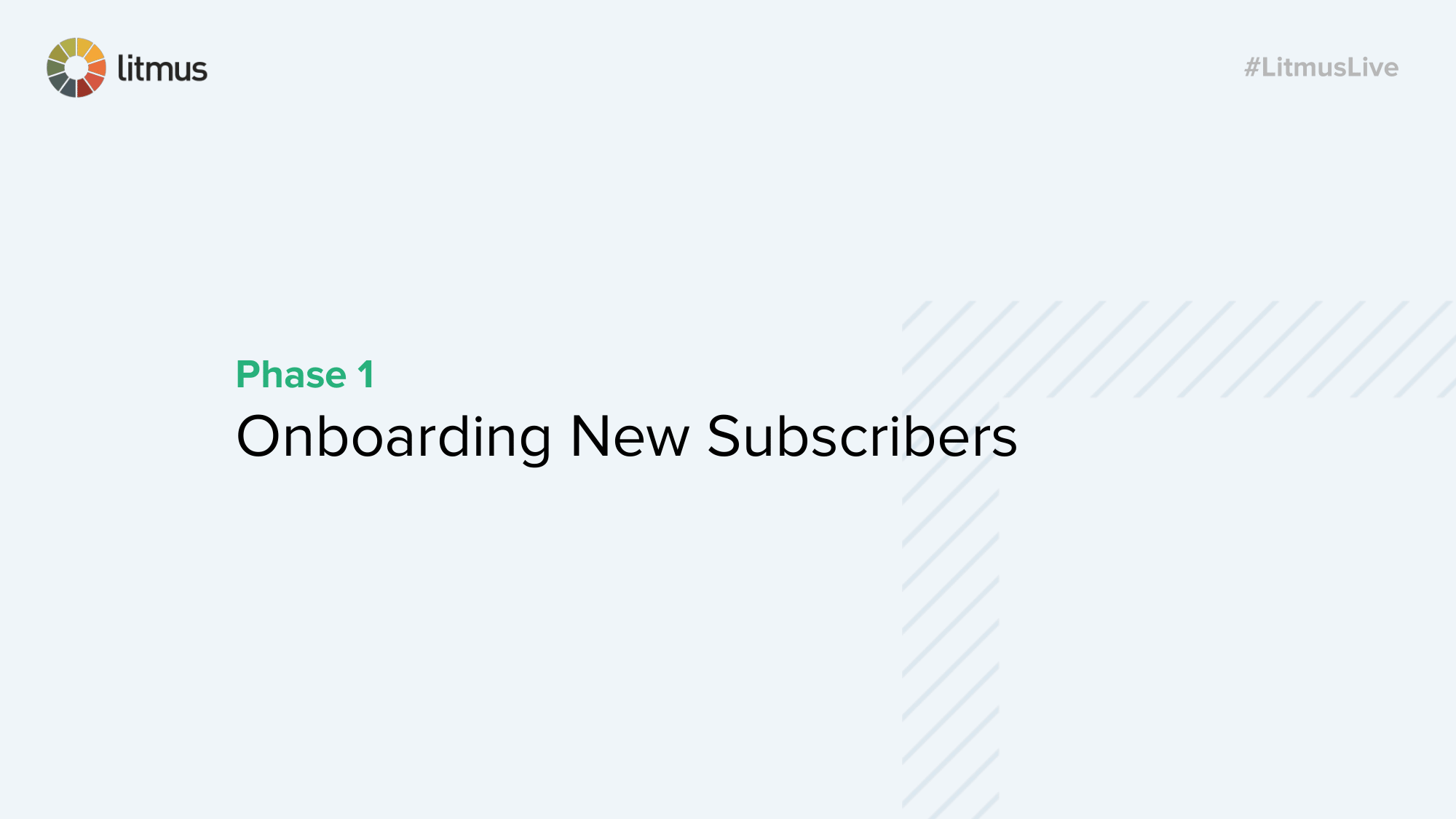
There's a lot of analogies out there about dating and we're not going to go into that today. There's a lot of loopholes in that analogy, but there are some successful things that you can do to onboard and welcome new users, new customers, new followers, new readers. So we're gonna hit some points out right now.

The first thing is to reinforce your value propositions. If somebody came onto your website or met you in person or they went to an event of yours pre-COVID, now it's a virtual event like you're doing right now. They liked what they saw and there's a reason that they signed up and they wanted your emails.
They might not know everything that's behind the curtain, so this is a great time for you to go and show them your value propositions. Why you exist, why you're doing what you're doing, and why you think it's a benefit to them. Then you also need to set expectations.
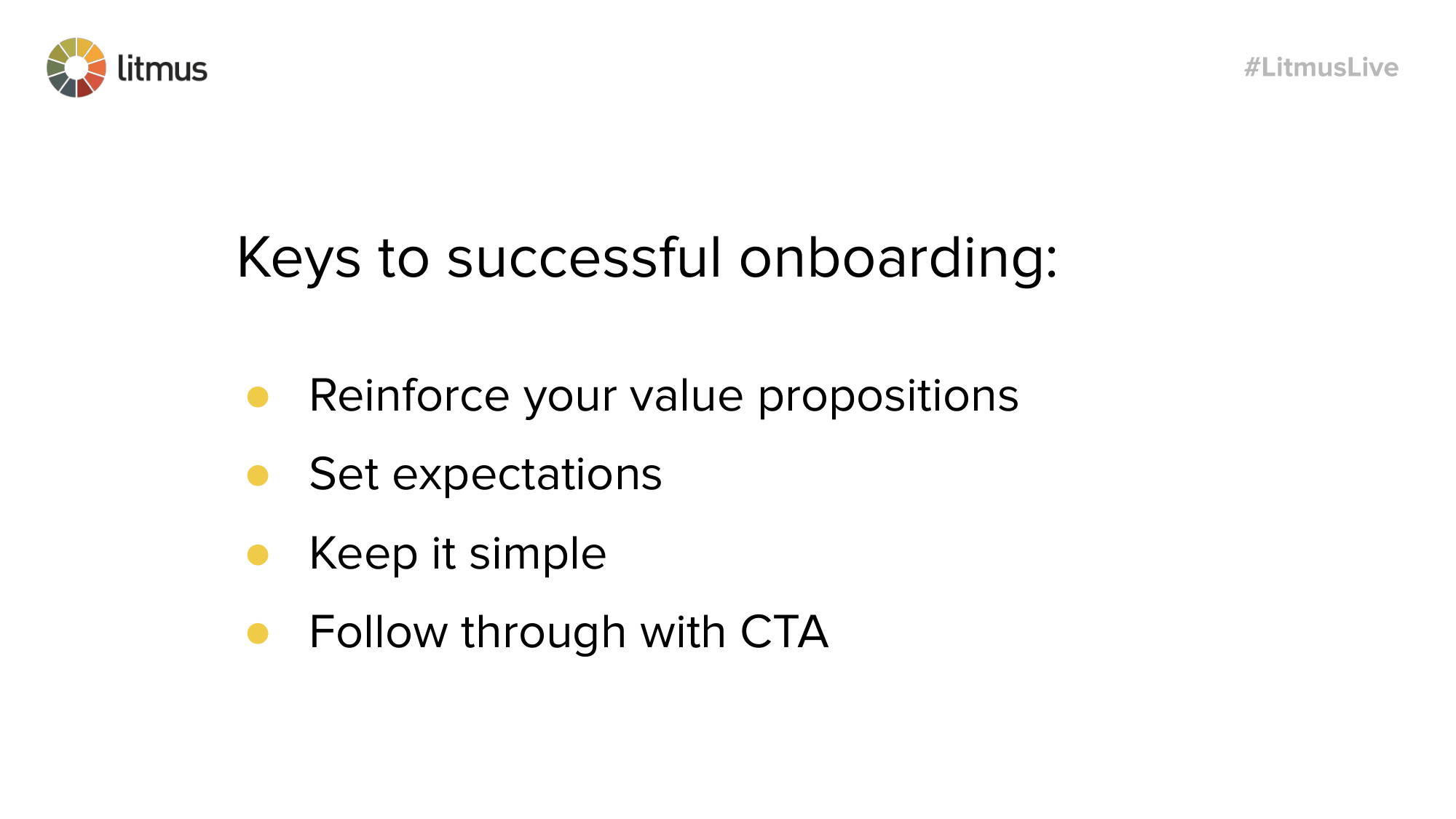
You don't want to be like the super creepy person who says that they're going to contact you every day or every six hours to follow up to see how you're doing. You need to make sure that people know what they're getting themselves into, following that relationship idea. You're not going to ask them to move in with you the first day you meet them.
Take it a little bit slow and then find out what they where they are at in the relationship. Then you gotta keep it simple. You don't want to overbear them or get too complicated with your messaging. You should have a very direct reason why you're contacting them. Maybe it is just a followup to something, but there's gotta be something there. The big portion of this whole thing is making sure that there's a call to action so they know what the reason is that you contacted them and what you want them to do based on the information that you gave them.
So I'm going to jump into some cool examples. There is this brand called The Dots out of the UK. They are a hiring and job messaging software platform. I just caught wind of them a few months ago. And like anybody else, I was like, Hey, this seems like a really cool company. I'm gonna give you my email address and see what happens.
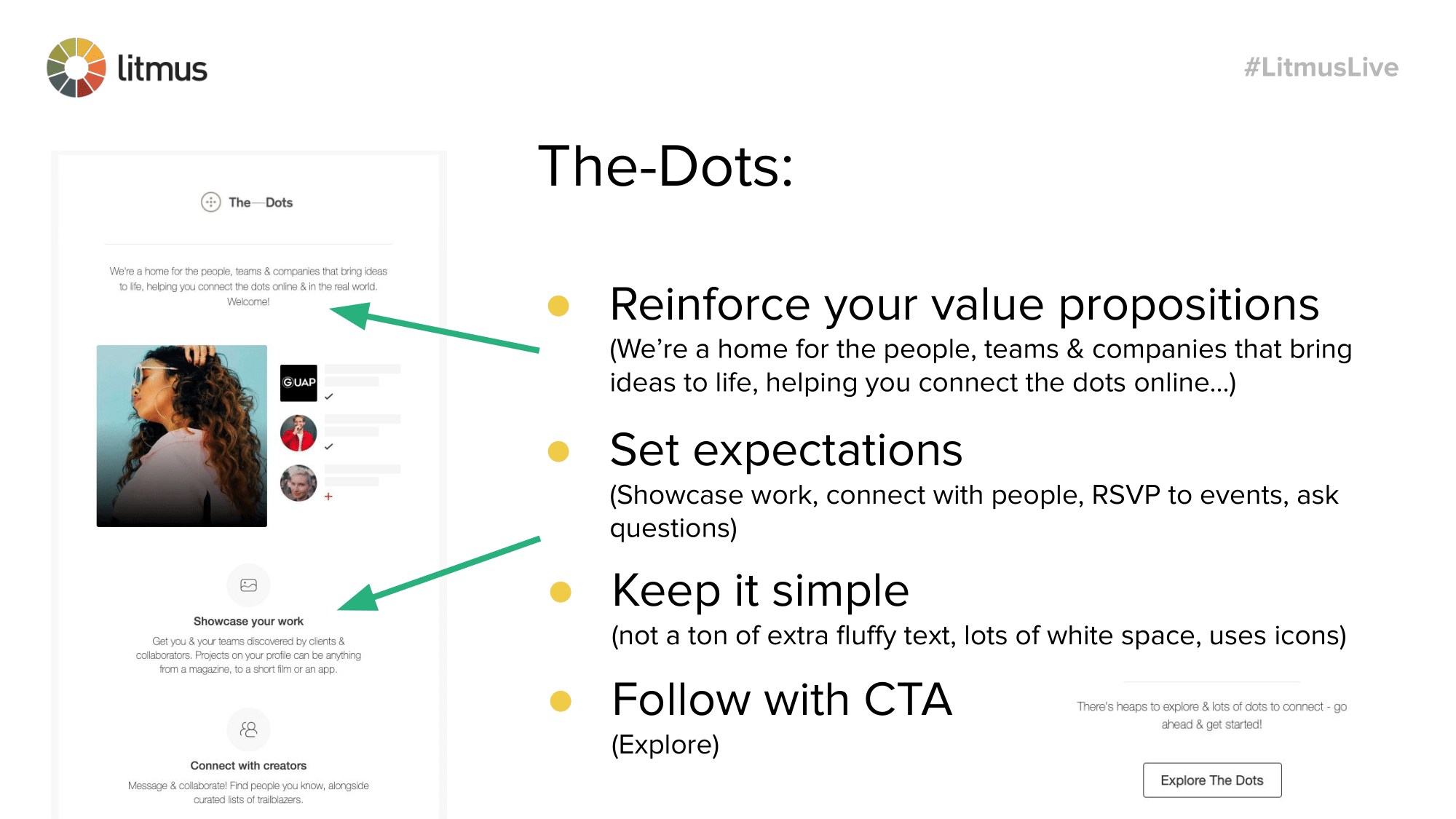
So this is the first email they sent. This is not like a double opt-in confirmation. This is the one after that. So they already know that I'm in it to win it. They start off by reinforcing their value proposition right away with, "Where a home for the people". They tell you upfront who they are, what they stand for, and what they're going to do for you. So they're setting expectations. As you scroll down in the email they want you to know that they will showcase your work and that they will connect you with creators that they have.
If you keep going down the email, you can RSVP to events they have. You can ask the community questions and get feedback on your resume or projects you've worked on. So they're all set up here upfront. Very simple. If it's not really wordy. It's just keeping it simple.
There's a lot of white space in this email. There's not a lot of fluffy text. They use icons to draw the eye down and you can easily skim it. Maybe some of these things are from the time you signed up or some things are new, but the icons really help out. And then at the very bottom of this email, they've got a simple CTA, which is "explore the dots".
They've given you quite a few options to start with and they know that this is just the beginning of the relationship. So they're trying to see once you get back to the site or back to their product what you're going to do. This is a good way to engage with somebody and figure out, Hey, we're going to set some expectations here that we're going to give you these tools.
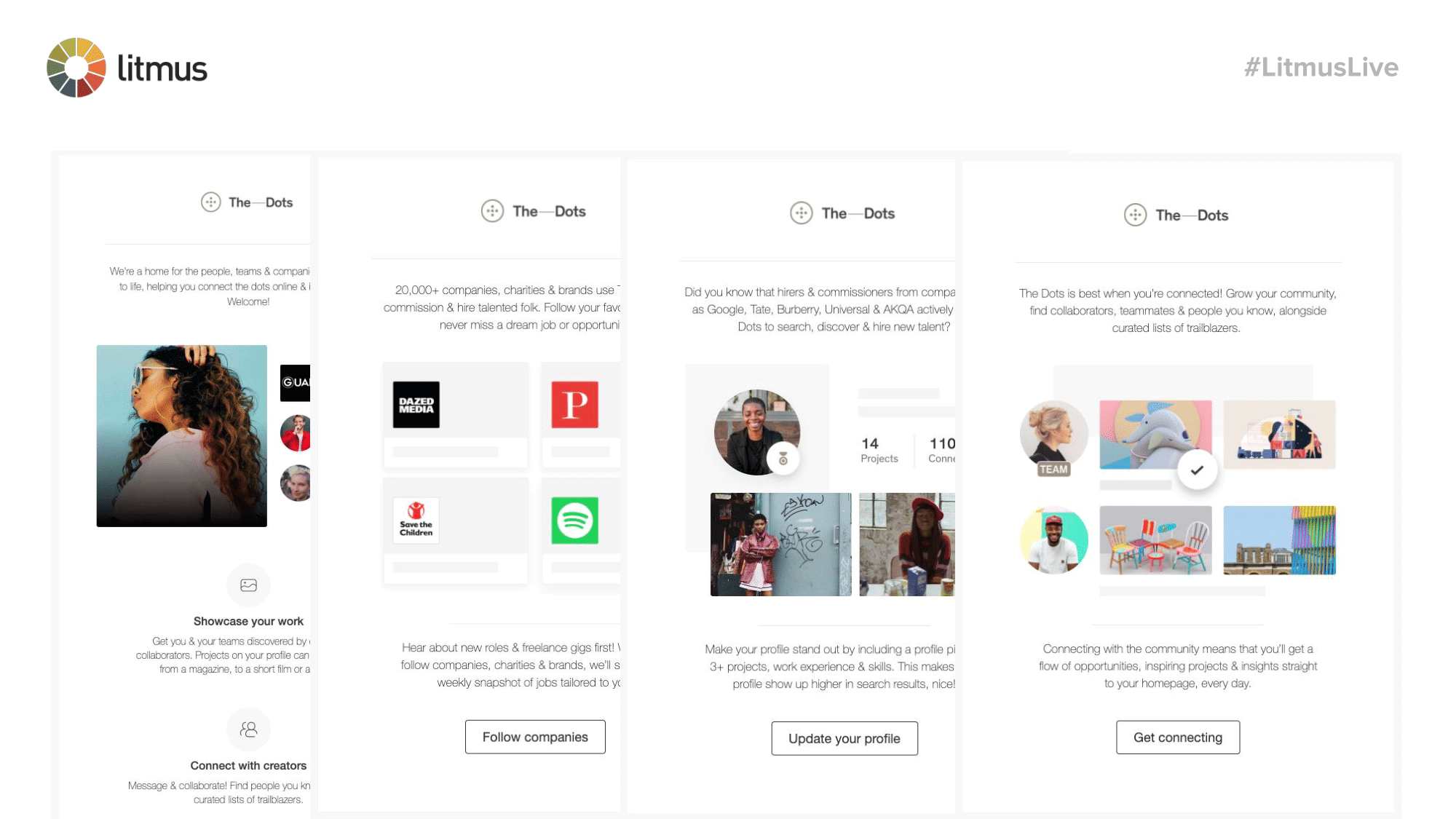
The next thing that they're going to do is they're gonna start sending emails to make sure that you're warmed up. When they send over this email, they want to create some FOMO. Don't miss out on this. You're really getting an insider track by using The Dots. It's more of an extrinsic motivator. So if you're familiar with extrinsic and intrinsic motivations, extrinsic are doing things so other people see you. That you don't miss something that others are doing. They're really tapping into that kind of a mode that this is something that you don't want to miss out on in that second email. They have this, "Follow companies" CTA to let you know there are some really cool companies using this platform and if you follow them you're going to get some value out of it.
The next email they send is adding some social proof to this. So there are brands that use The Dots. This is more again for an extrinsic motivator, but they're also showing some opportunities to learn something new and they want you to update your profile.
So not a lot of people are going to get something out of updating their own profile. This is now for other people to see your profile, see what you're doing. And this is tapping into this intrinsic motivator. There's a reason that you came to us. There's a reason that you want to develop yourself.
If you're selling shoes or selling tax services, there's a reason that people came to you. What is that reason that you can tap into to make that person a better individual? And so, as they transitioned to intrinsic motivators, they sent this last email, which is the fourth one to improve your chances of being discovered, and meet new people.
This is again, building up your own community and finding people to talk to you, learning new things, and creating a safe space for yourself to be creative.
Those are the first four emails that you get from The Dots. They walk you pretty closely through what they want you to do, but they are also are touching on things that are important probably to you and why you wanted to engage with them in the first place. They remind you or point out new features that you didn't see when you signed up.
I said in the very beginning, you don't want to be sending too many things all at once. So the cadence is the first day you signed up is that first email. Then on day two, is when you get that second email and then you might think, okay, day three is the third one, but no, they know to not pepper you every single day with something. Here you want to wait and see what your subscribers do with your product or your platform or your services.
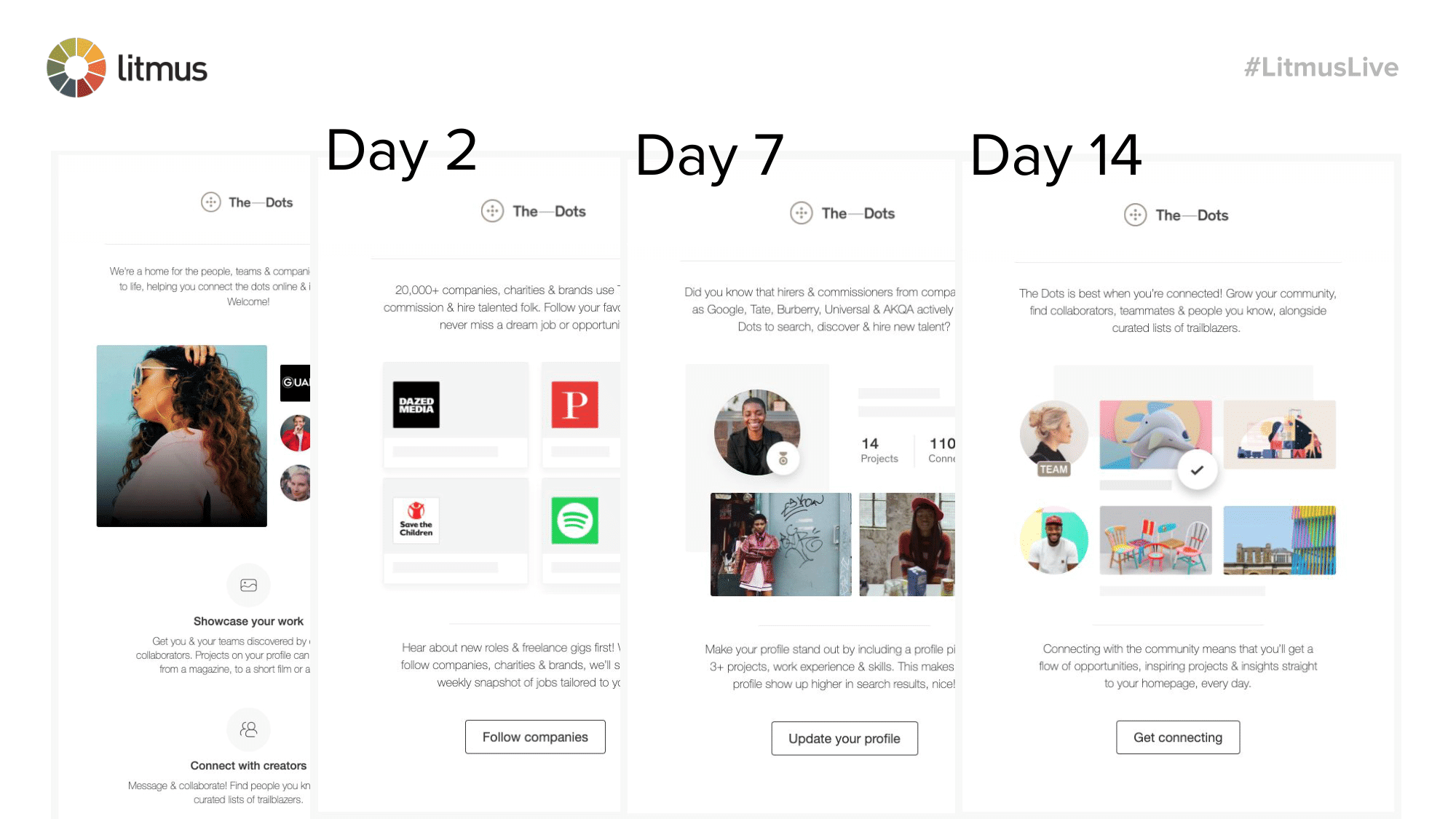
They move on to the wait another five days before they send something out. And then again, another seven days till they send out the next one. So they're slowly moving you away from everyday contact and just now remind you of things that may be important to you. And as you engage with the site more and update your profile, you're going to get different kinds of messaging.
Which is really cool. They're going to start tailoring these events, different companies, different people that you should follow based on the behavior, which I love. I love that there's this whole one-to-one relationship that's being built as you are being onboarded to their process.
Thinking about your company and what you're doing, maybe those are ways to bring them in to try products, talking to new consultants, getting them engaged more on your app, there's whatever you want, whatever you're selling, there's definitely a way to keep them engaged and reminded, but also not be overbearing.
If you also look at these emails, they're very simple. There's only a few lines of text and images, another couple of lines of text, and a call-to-action. They're not going into this long-form email about their background and where they were born and why they started the business.
There are places to do that. That may be in a welcome email. That may be a call-to-action to read more about the history of the business. What they're really doing here is staying consistent in their design elements and using a design system here that's really recognizable. So the next time you get an email from The Dots, you've been conditioned on what to look at, where to look at it, and what kind of information it'll have.
There are lots of onboarding emails out there. Lots of different kinds of types. There are plenty that you will find on ReallyGoodEmails.com as well.
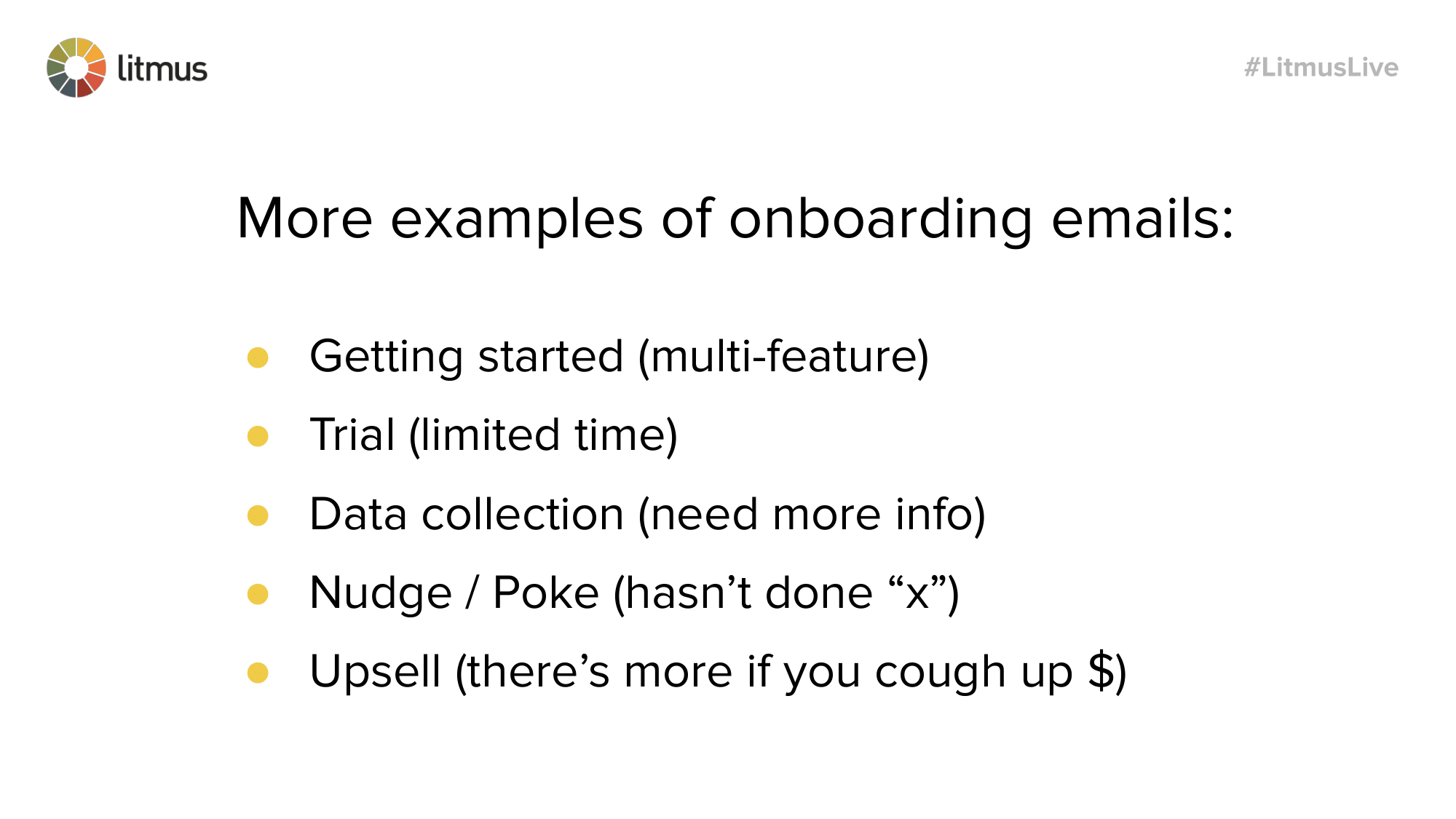
When I say it's a multi-feature, I'm thinking of something really complex as a product. So maybe like a car company. So if you just bought a Honda, they're showing you different aspects of the vehicle that you probably didn't know about. Or like Canon cameras, the things that are a little bit more complex to show off in just one email. Spread it out over multiple emails and show different features that make that complicated system or service or product easy to digest.
For the trial example, this is something like Audible. They're letting you know that you only have a few days left to download something.
The next one is a data example where they're trying to understand your profile and what your behaviors are and what you like. They're asking you for more information. An example that I recently came across was National Geographic. When you first sign up, you get a welcome email and a couple of emails after that. Then they send you one email that says, here are the topics that National Geographic covers, which one are you interested in?
And when you click on one of those topics, The following emails are only dedicated to that topic. They've left out the stuff that you don't care about, which is really cool when you start thinking about data collection within the onboarding process.
A nudge example would be something like Pinterest. If you use Pinterest, letting you know that you haven't finished your profile yet, or that there may be a Pinterest board that you need to create or you haven't created something in so many days. That is a really good example to keep people engaged. This is not a winback. This is something that's sent within the first couple of weeks of you using their system or their platform or their products. It's not trying to say, "Oh crap, they're not coming back anymore". This is just a simple reminder.
An upsell example would be something like Hulu. You go through the rest of the onboarding process, but then saying, "Hey, do you want to do Hulu Plus where we take away the ads for you?". Because we see that you're engaged with all the other emails that we've sent you and you're engaged on the platform. We think that this would be a good experience.
Or it might be belts with the jeans that you just purchased. So those are all, some examples of onboarding. Again, it's bringing on this relationship. You want to take it at a good pace. You don't want to be too overbearing. You want to set expectations. I think a lot of those are going to follow through as we go on to what a long term relationship is. So I'm gonna hand it over to Val and she's gonna talk more about this, cause this is what she does and she's really good at it.
She can talk to it better than I can.
Val Geisler: Thanks, Mike. So onboarding is the first step in building these long term relationships because you can't really do this second part, unless you've done the first part.
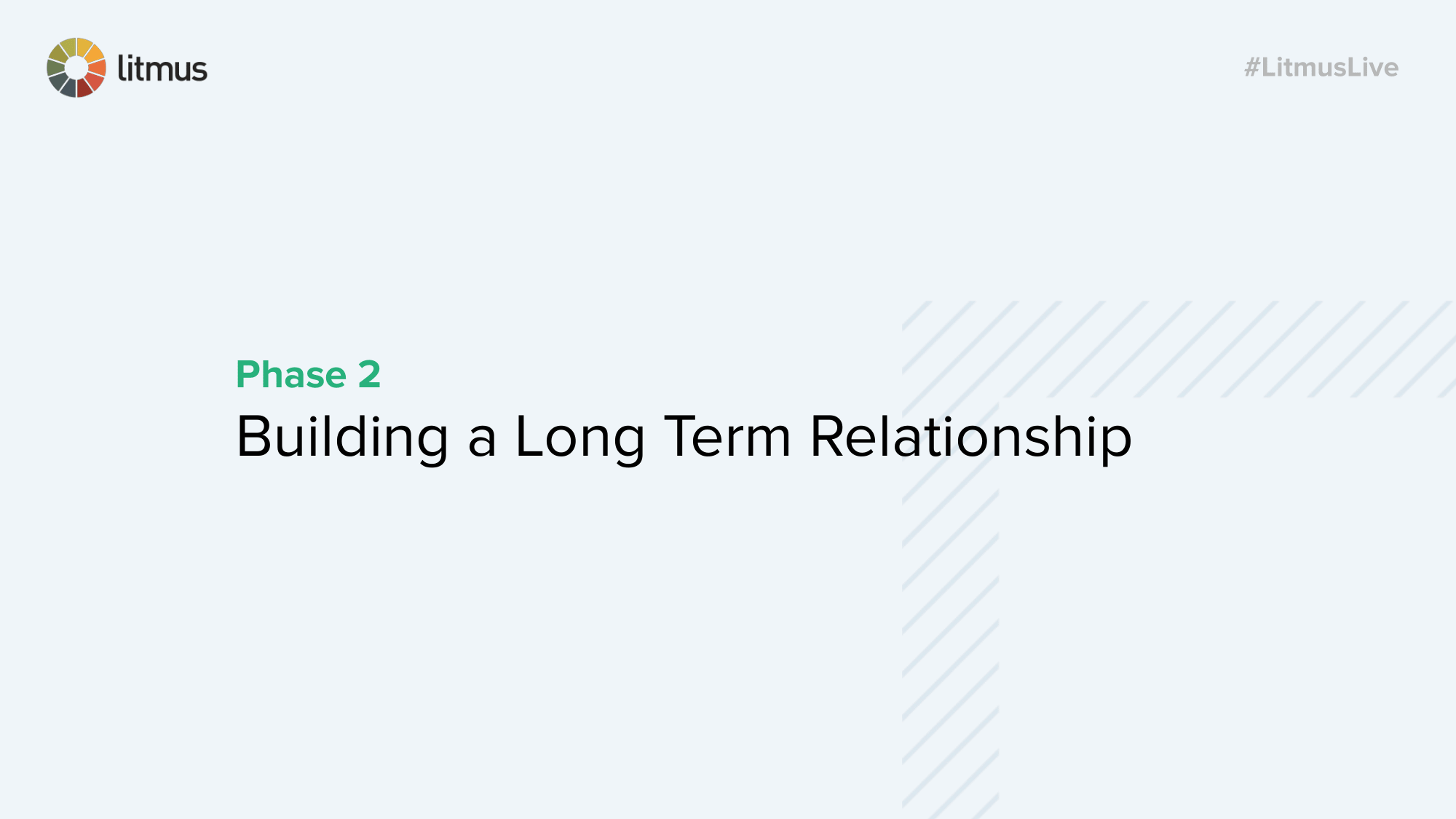
It's really weird to not hear from somebody for a very long time and then all of a sudden have them back in your life regularly. The same applies to email. We want to use email to build long term relationships, especially when you have a subscription-based business. There's a tendency for subscription-based businesses to only send receipts every month or only product-related emails. Whether it's shipping and delivery notifications on the eCommerce side or product updates on the SaaS side, that's the standard.
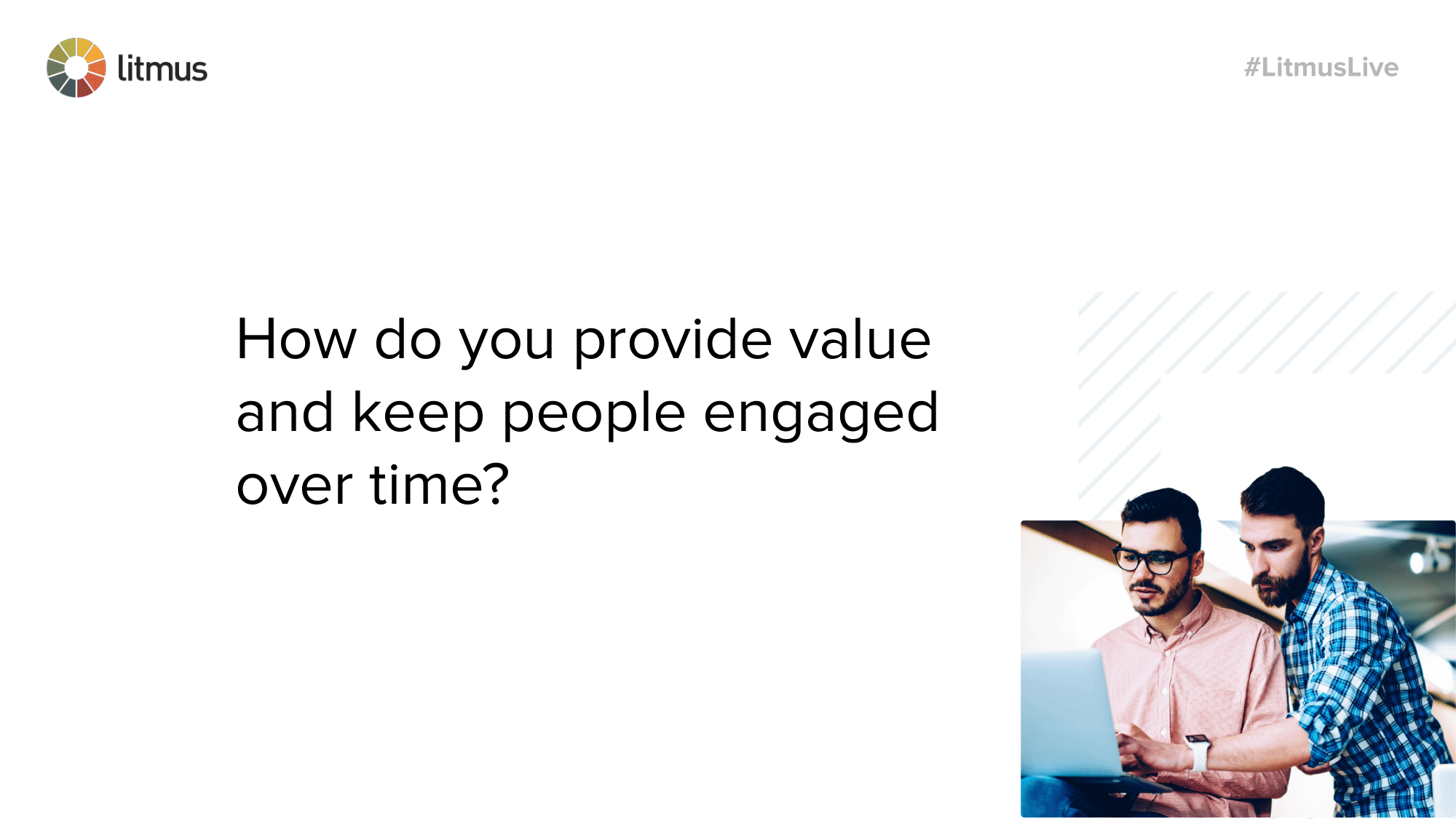
I'm a champion for, increasing that standard to more regular communication. The best way that you can provide value and keep people engaged over time is to show them that they are more than a credit card. That is by saying like, Hey, just because you have signed up for your subscription or made your purchase with us, it doesn't mean that now, we've got you and we don't need to talk to you anymore.
There are so many more conversations you can keep having. It's one of the reasons that I love this kind of like long term retention.
There are different concepts around the definition of onboarding and retention. What we're talking about here is more long term retention. So how do you talk to people who've been around for an extended period who've made several months worth of purchases with you on your subscription or have been a customer on an ongoing basis? What do you do besides send those receipts?
There's a couple of ways to tackle retention and it's going to vary company to company and what your relationship looks like with your customers now. I have four examples here for you, but there are so many more ways.
We'll dive into these, but there are a lot of examples that different companies have and actually on Really Good Emails. There's a retention category. So there are several examples of ways you can increase retention.
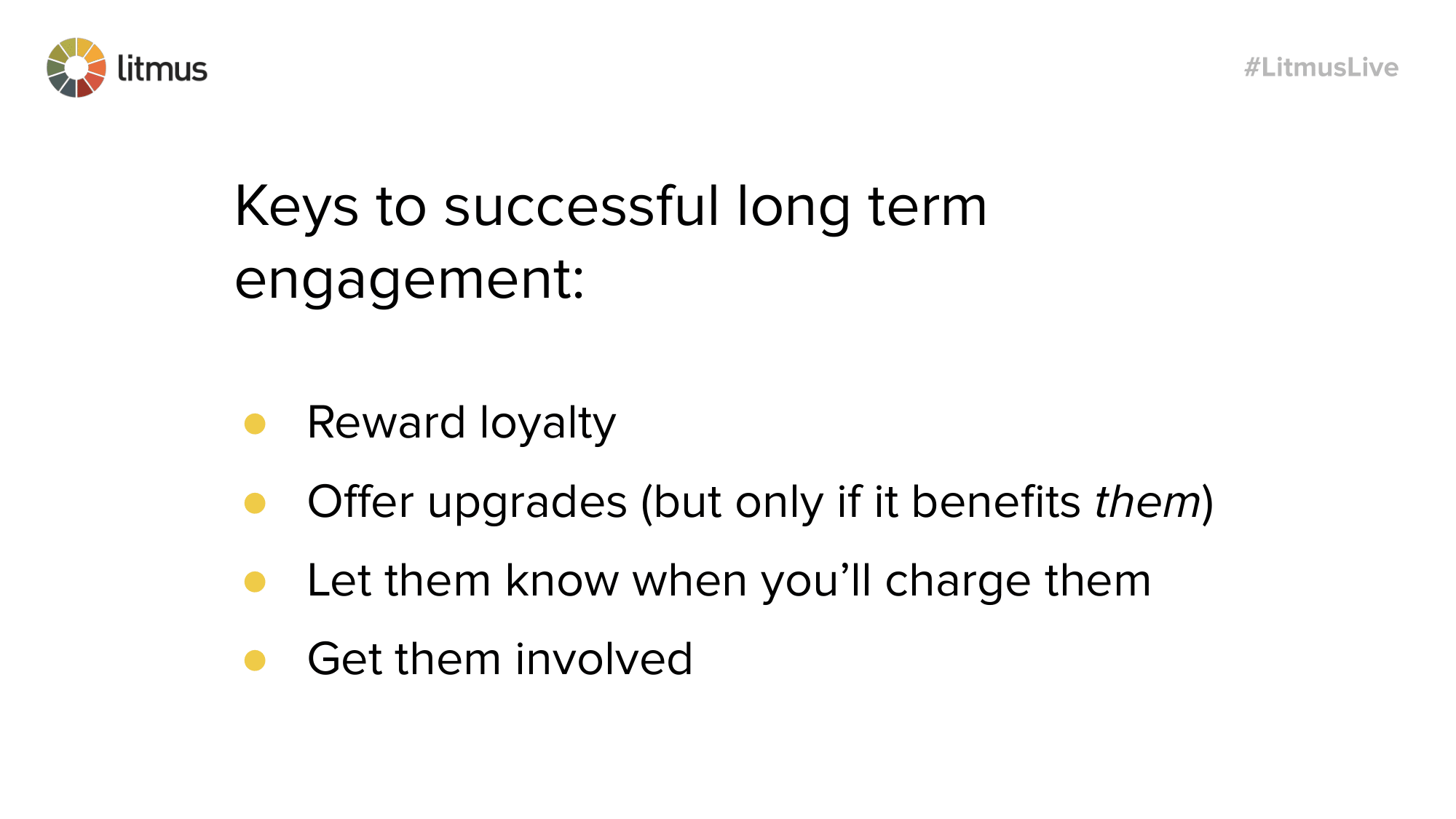
Rewarding loyalty. Making sure that they understand, again, that they're more than just a credit card to you, that they matter. All human beings want is to feel seen and heard. If you can do that with email, you'll have a customer forever.
Offer upgrades. I know we talked about upgrades in onboarding, but this is a valid part of your retention phase as well. Just make sure that the upgrades benefit them. That it's not just all about you and getting more money out of them, but making it speak to what they purchased. Like Mike gave that example of belts with jeans that you just purchased. So making sure that those upgrades benefit them.
Letting them know when you'll charge them. Now, this is something that I encourage for anything that's a greater frequency than monthly. So if you have a monthly subscription, you don't necessarily need to do this. If you have anything like a quarterly or people who are on the annual plan, you definitely want to let them know when they're going to get hit with a $400 charge before it happens. Yes, you will see additional cancellations, but you'll see fewer chargebacks. So that's fun.
Get them involved. Get them involved in your brand in sharing your best customers. Your long term customers can be an entire marketing channel for you. I like to think about what if you canceled all acquisition campaigns. If you no longer ran any ads or even allowed new customers to join your platform, how would you continue to grow your business? It is through your existing customers. If they can send people a special link to be able to join or buy from you, then they have that power to help grow your brand.
They do also have the power to kill your brand. We know all about that in the cancel culture. This is one of the reasons why you want to continue an ongoing relationship with your customers so that you keep them close and keep them happy.
I'm going to share a few examples with you of those four that we just went over.
The first one is, giving them the offer. With this email, I really love it because it came to me. So these are all actual examples from my inbox. I was a MeUndies subscriber and I got this long after I had started using the product. I think it was probably the second month of my subscription when I was asked to refer a friend. The kind of default in eCommerce is to send that referral request, either immediately after purchase, which like, why would I tell anyone about this product if I haven't even tried it yet? Or before it's even delivered.

So I would encourage you to send these kinds of emails after they have had a chance to use the product. See what happens, if you get more referrals, if you push this back. This is also can be a standalone campaign that you can drip out over time. Don't just talk about your referral program once and let it go. Continue to talk about it in different ways and share experiences that other people are having. Jennifer referred so many people that she had three months worth of free undies as an example.
You can tell the stories of your customers. You want to go in asking them to spread the word about your brand, give them something for their efforts.
So this is, "Give your friends 20% and get 20%". The 20 and 20 is kind of tired. I would say a lot of companies do it. So try and think about how yours can be special and really stand out for your customers. Then get super clear. Don't throw this at the bottom of another email, make it its own campaign. There's nothing else in this email other than the footer. This is the entirety of the email. So it's super clear.
This is an upgrade idea. We're going to encourage upgrades that are relevant to our customer's purchases. Again, I'm a customer of KiwiCo for my kids. This upgrade is in connection with the product that I already subscribed to. The other thing that they're doing here is they are showing what it looks like. They're showing an example of this product and the way that it connects to my existing subscription.

So this is where those images come into play. This is actually a carousel or it's a GIF, but of rotating options, because everybody has different types of subscriptions and you can subscribe to multiple things at once. The other thing they're doing here is they are offering it for free for one month.
So they're saying, Hey, try it out, see how you like it. They're pulling you in as a customer and saying, add this, go do this upgrade. What happens is we forget that we added the upgrade and then we get it the next month. It's already on my account and I'm just going to keep it up. It's a really easy thing for me to continue doing after I didn't pay for it the first time.
You want to make it super relevant to them. Let them know that this is actually going to move them onto the new subscription. So this is the deluxe subscription that they're referencing the fact that this is not just an upgrade this one time, but it's changing your entire subscription and you'll continue to get a new book every month.
So I really love that as the upgrade option in the retention sequence. This came after I had my second Kiwi crate. So again, we're talking about those second and third purchases where we want to see these things.
This is a before you charge them, let them know what's happening. Lume is a deodorant that I highly recommend if you need a natural deodorant. and they are e-commerce, DTC only. My subscription is something like every eight weeks maybe. I'm not actually positive. But because it's not every single month, I get a notification from them that I am going to be charged that the next shipment is shipping on this coming date. Then they say, Hey, if you don't need this right now, you can click here to delay your order. I will tell you, folks, this is the easiest process.
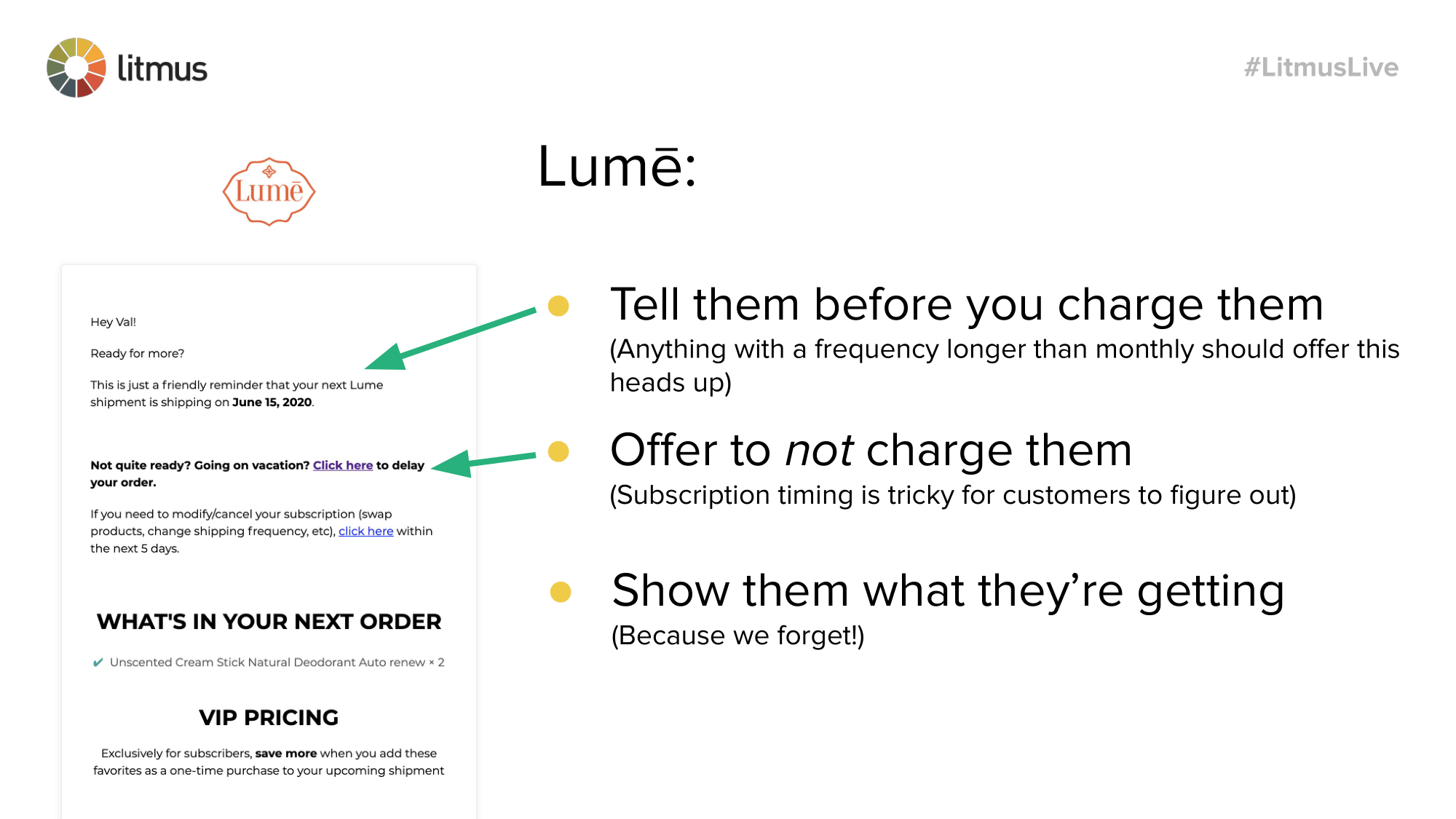
I clicked and then I chose from a drop-down how many, or what day I wanted to delay too. That was it. I didn't have to log into a dashboard. I didn't have to fill out any complicated forms. It was super simple and it made me fall in love with this brand even more. It does give me the option to go into my account and make any modifications or cancellations inside of the account.
The other thing is it tells me what actually is in my next order, because we forget. We forget what we had for breakfast this morning. To ask your customers to remember what's in their order that they placed, or even have, a running basis from eight weeks ago, it just doesn't create a great experience for your customers. This is an incredible email and not enough companies are doing it.
Then the last one. This is getting your customers involved in your brand. Canva here is asking their customers to share their designs. So this is a bit of a Christmas competition. They want you to use a hashtag. So they're building their brand recognition with a particular hashtag. If your company doesn't have a custom hashtag create one for a campaign.
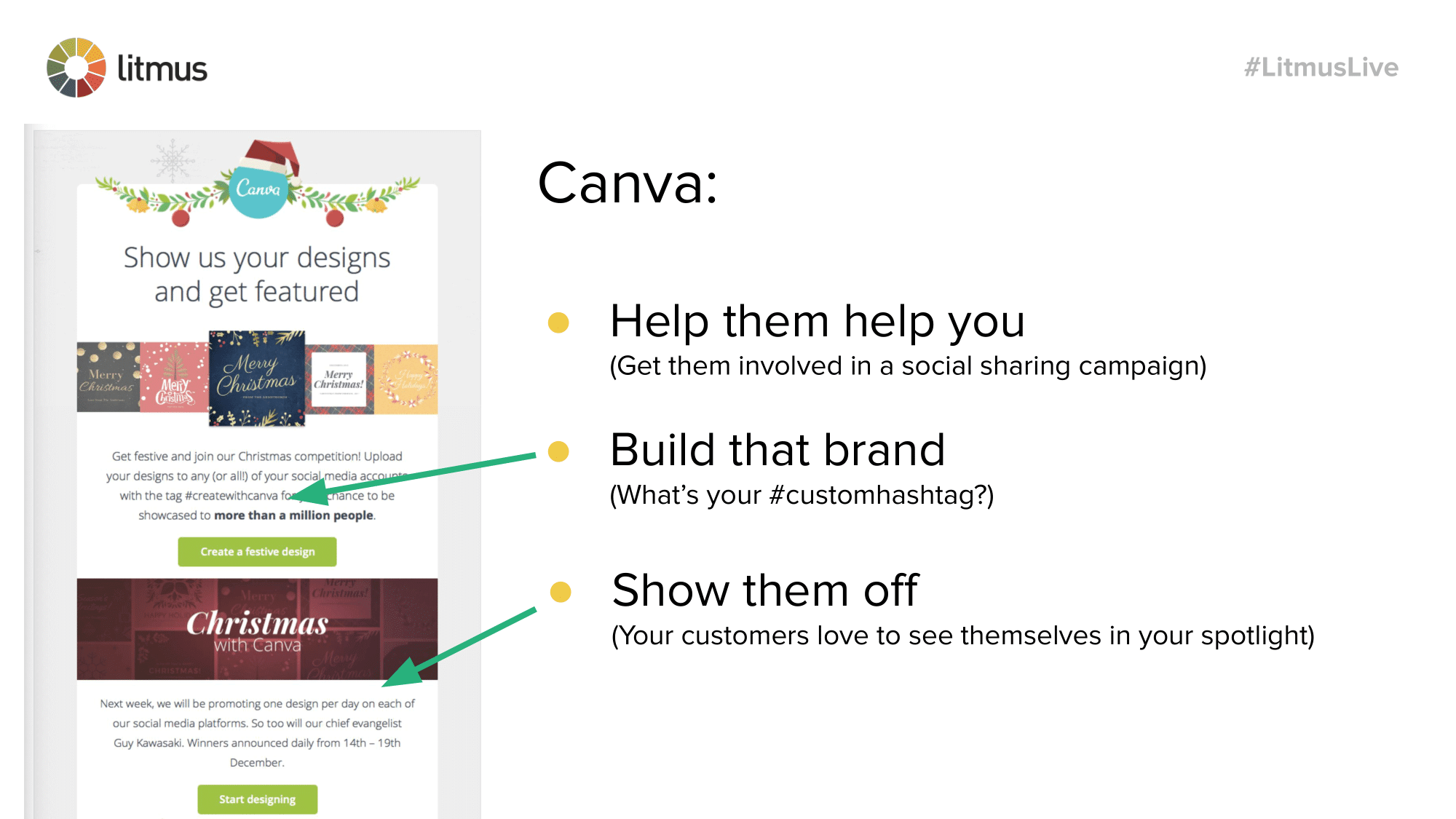
Help them help you by this is them referring their friends in it's an inherent referral, right? It's them publicly saying I use this platform and I love it so much I'm sharing this information, whether it's their own image they created, or maybe if you have a physical product, it's them wearing or using the product.
There are all different ways that you can get your customers involved in showing off your product. Then return the favor they're showing off your product and use your larger platform to show them off. People love to be seen and heard, and there's no better way to do that than to show them off. To say, Hey, here's our really cool customers and we want you to know about them. This is especially true if you are in B2C.
Your customers want to have their story told, and your brand offers a platform that they don't otherwise have. So return the favor when they're sharing the love for you. There's like a dozen more ways to talk about retention, but the next phase is super important to winning back lapsed subscribers.
So I'll turn that over to you, Lyla.
Lyla Rozelle: Thank you so much. Okay. So I was going to use a relationship analogy, but now that Mike has called them out, I'm not sure what to do.

That's always been my go-to, but he's absolutely right. There's plenty of loopholes that make it fall apart pretty quickly, but regardless if it's not like dating, it's definitely a relationship. Sometimes every relationship needs to have a little magic back in it and needs to reignite the spark.
Val has this great analogy about the dinner party. Maybe the dinner party needs a little bit of a song change. A tempo mix up. So now how do you reel them back in? I think there's going to be a lot of similar threads or things kind of weaving throughout a lot of these conversations because so much of what makes email really good is consistent throughout pretty much every step of the process.
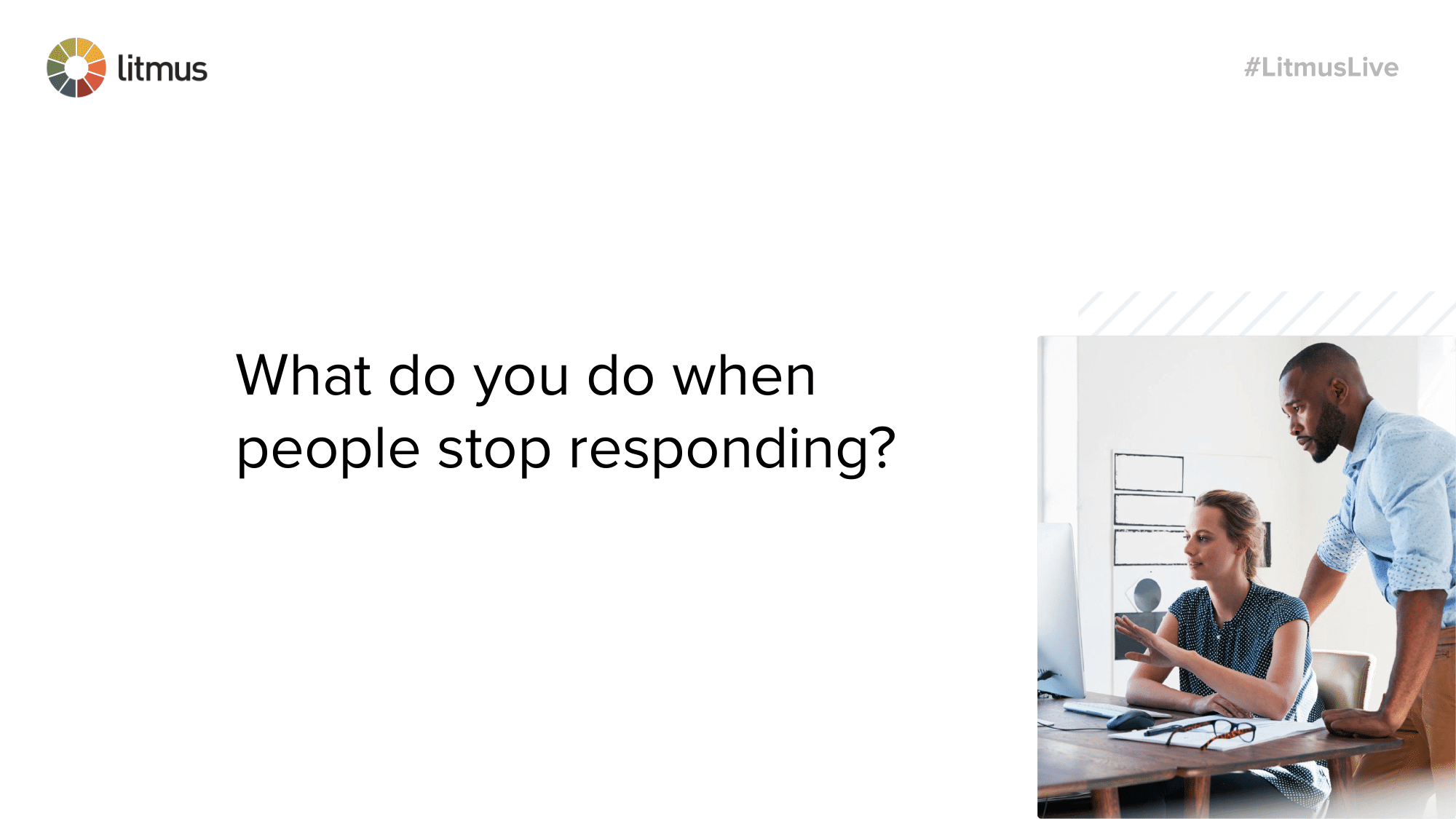
You may see a lot of these things that we've talked about repurposed for each step. I think that's pretty interesting and I'm glad that we're kind of all aligned on that.
So similar to kind of what Val just talk about, I like to share a strategy that the great American writer, David Sedaris, once shared. He says that whenever he likes to go out to a store, he tries to make the transaction more about the conversation and the moment that he had with the cashier or the person working and himself, he likes to learn something about them. Have a memorable interaction that puts that little spring in his step for the next part of the day and kind of makes it go beyond just feeling like that kind of transaction.
When a business transaction is taking place, sometimes it just kind of feels split. I always kind of feel like I'm trying to replicate that feeling with email. Of course, it makes it a whole lot easier if you have that messy middle, that Val talked about, fleshed out with great emails that are working on building that relationship and helping your subscribers learn more about you and vice versa.
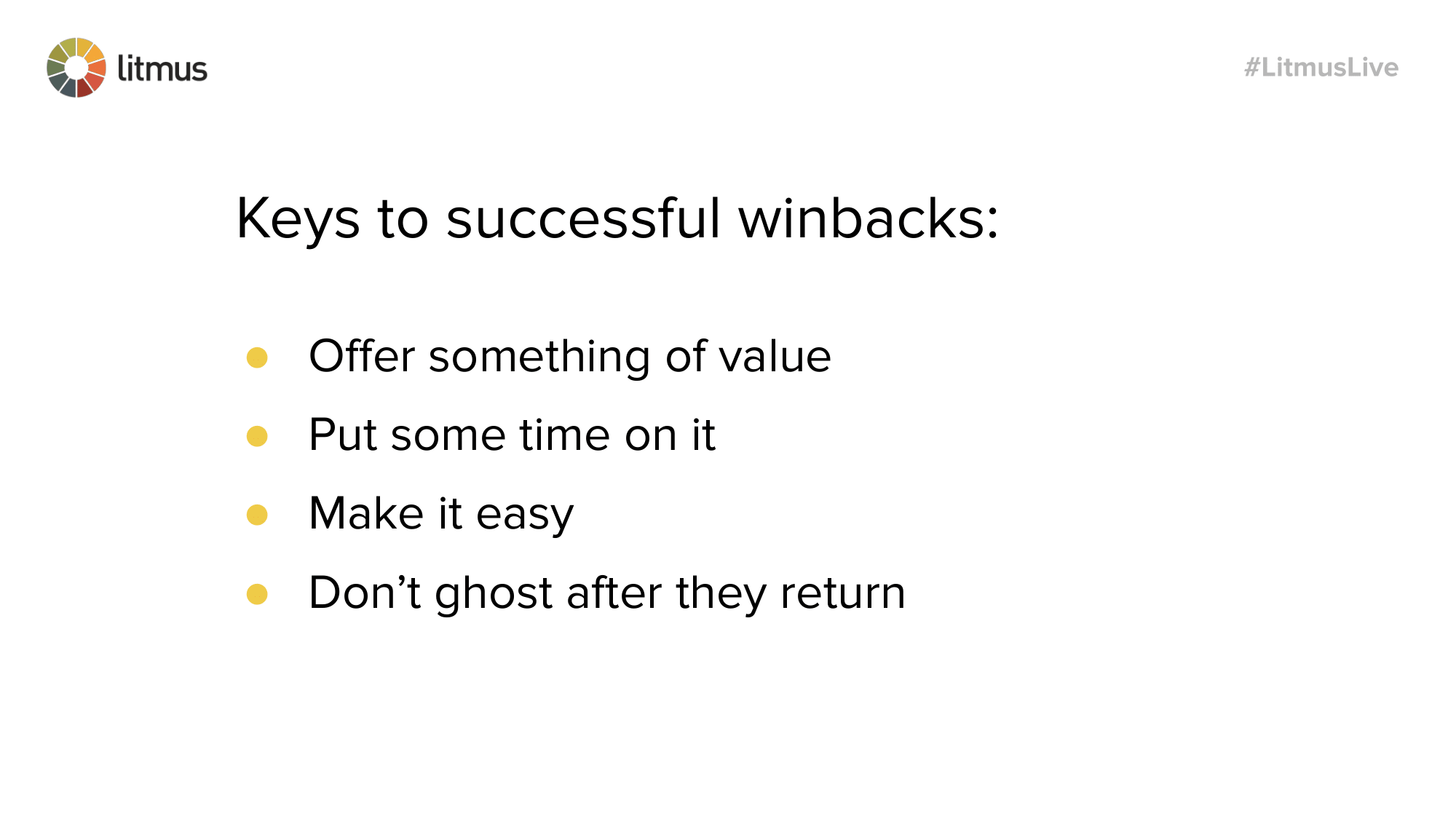
Even better if you've really set that up in the onboarding phase as well. Each part kind of feeds into itself and even if they've canceled, if you've sent them off nicely and they had a great off-boarding, that's so much easier to try and win someone back then desperately trying to prevent someone from canceling.
To Val's point, not telling them when they're going to get charged, not wishing them well, not letting them easily leave. Trying to win them back after that is way, way harder. You have to rebuild the trust that you've established to get them to sign up for your emails in the first place.
If someone's checked out of your emails completely, definitely make sure that your next touch brings a ton of value. I'll show a couple of examples of companies doing that. You can't really set and forget a solid win back program. Not that you can really do that with any emails, but winbacks are something that kind of need to be discussed recurring,
With every campaign or launch or upcoming event, it's a good bullet point to add to your kind of kick-offs like, Hey, how can we get lapsed customers to check this out? Or what can we do to bring people back as a result of this campaign? Those types of discussions are really good, even if it's like a small group of people. A lot of times it's repurposing some of these discussions and emails that you've already had, but for a different audience.
After going through a ton of examples and working on a lot of winback campaigns myself, I think there are a few key elements that boil down to honestly, very similar to most of the key principles of great email. Make your email valuable and mean something to your customers through content, knowledge, or product offering or your community.
After you do win them back, let's feed them back into that lifecycle that we've been talking about this whole 40 minutes or so. Don't let them just disappear again for another few months until they get another winback campaign.
To me, that kind of feels like my relationship with my parents. I'd never call them till they guilt trip me and text me and get them to call them. Then there's a lot of waiting. Then all that kind of happens again. So don't be a bad kid like me. For your customers, definitely keep in touch and don't just try and ask for something out of nowhere and then disappear again.
We'll get into my examples now. I'll share a few that just kind of run through some of the key elements that I mentioned above. The first one here is from American Airlines. I got these all on Really Good Emails, so you can find them there.
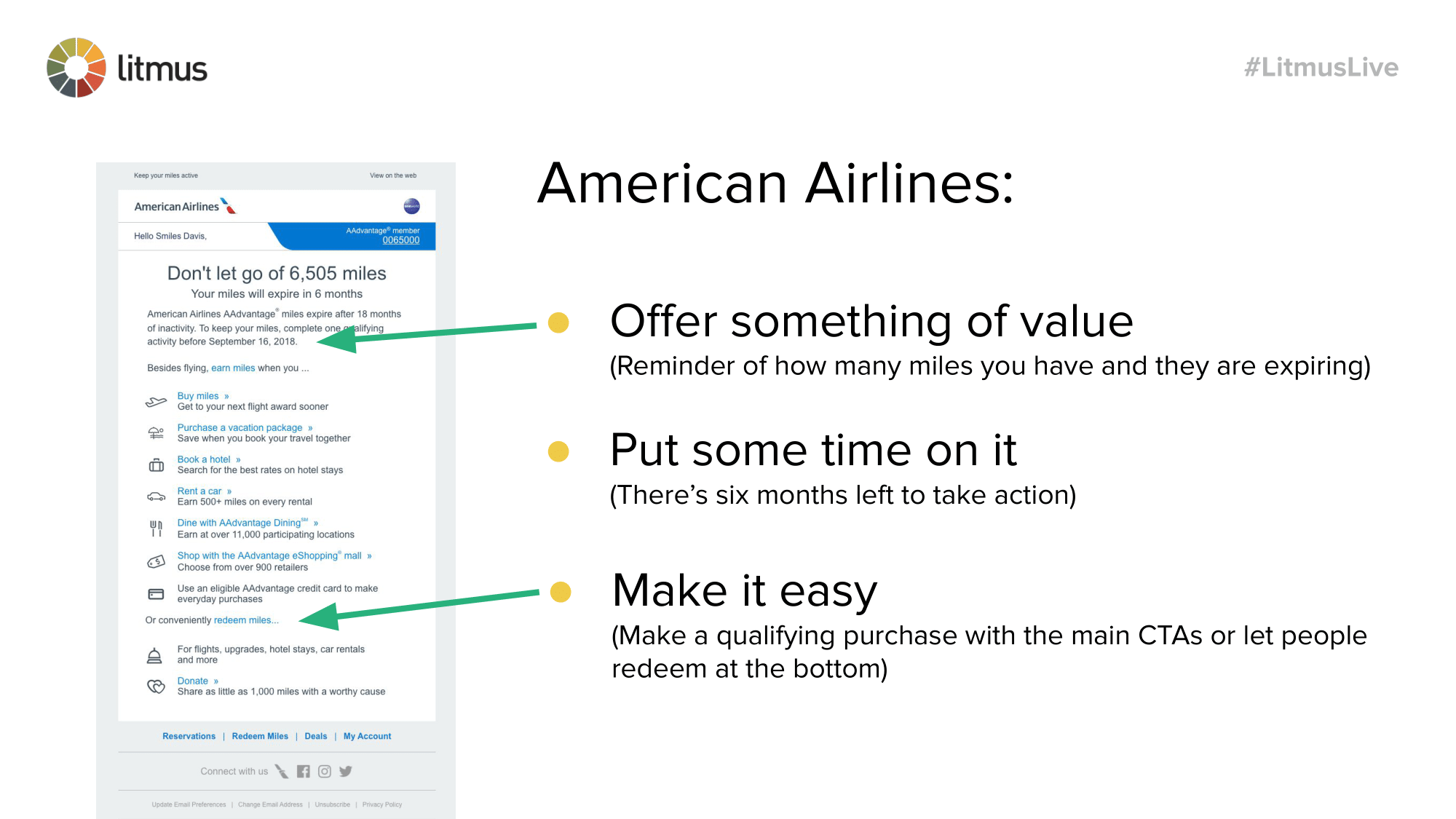
Here I'm learning that I could lose miles if I don't make a qualifying purchase on my credit card or go ahead and like redeem the miles. American Airlines wants me to make the purchases. So they've given me a bunch of ideas on how to spend that money with all these CTAs, all these links, which I like. There might be a lot of links here, but I still liked the approach in general. I like that they have some time listed here, but it's not "act now" and it doesn't feel cheap to me.
It also has your rewards number at the top, so that if you need to call and ask a question or you want to log in, you can make sure that it matches up with the email. It also makes the email feel a little bit more secure to me and more personalized, but not overtly.
Not like a, "Hello Lyla, we see that your birthday is XYZ". Just leaning into the personalization because they're trying to check a box. I really like that it's used here a little strategically. Another example of this might be like a login button or other things that kind of tie back into how they've used your product or what they've purchased. So you can build that security up.
The next example is Unsplash. This is a nice example of a little nudge, but that's not an onboarding nudge. This is someone who's already done something a while ago, and they're trying to get you to do it again.

I love the hero image. It's nice and attention-grabbing. I like the copy. It's not trying to do a ton of things at once. The focus on this email is really sharp. A lot of times when we want to win customers back, a little bit like in the American Airlines example, we can get too excited so the message can get a little muddled. Like, Oh, we want them to do this and do that and do this. But here Unsplash has obviously determined that contributing a photo is really important for them and that's pretty clear. There's also a little CTA below the fold that says the same thing.
So, this email is good. It gives us a nice little bit of sneaky FOMO. Hey, this is what's been happening without you. This is like a sister email to a few of Mike's examples in onboarding, right? They're using that extrinsic motivation, plus their previous knowledge of you to get you motivated and do that nudge.
One cool thing that could kind of take this email to the next level, or even maybe target people, in a different group would be to target people who have posted topics in these trending topics before and say like, Hey, your topic is trending. Get your eyes on the photos, go post something, you'll get more visibility, something like that. Something that's actually going to help your customers get more value out of your platform. It doesn't just serve you.
We can head over to my last example. So, Asana will always be in my examples. I'm sorry. It just happens that they have a lot of great emails for what I often want to talk about. This is more for product launches, but the design of this email is a showstopper, in my opinion. I love the copy. It lets me know that something has changed at Asana without having to decode like some marketing speak or a scroll around or get some teasers.
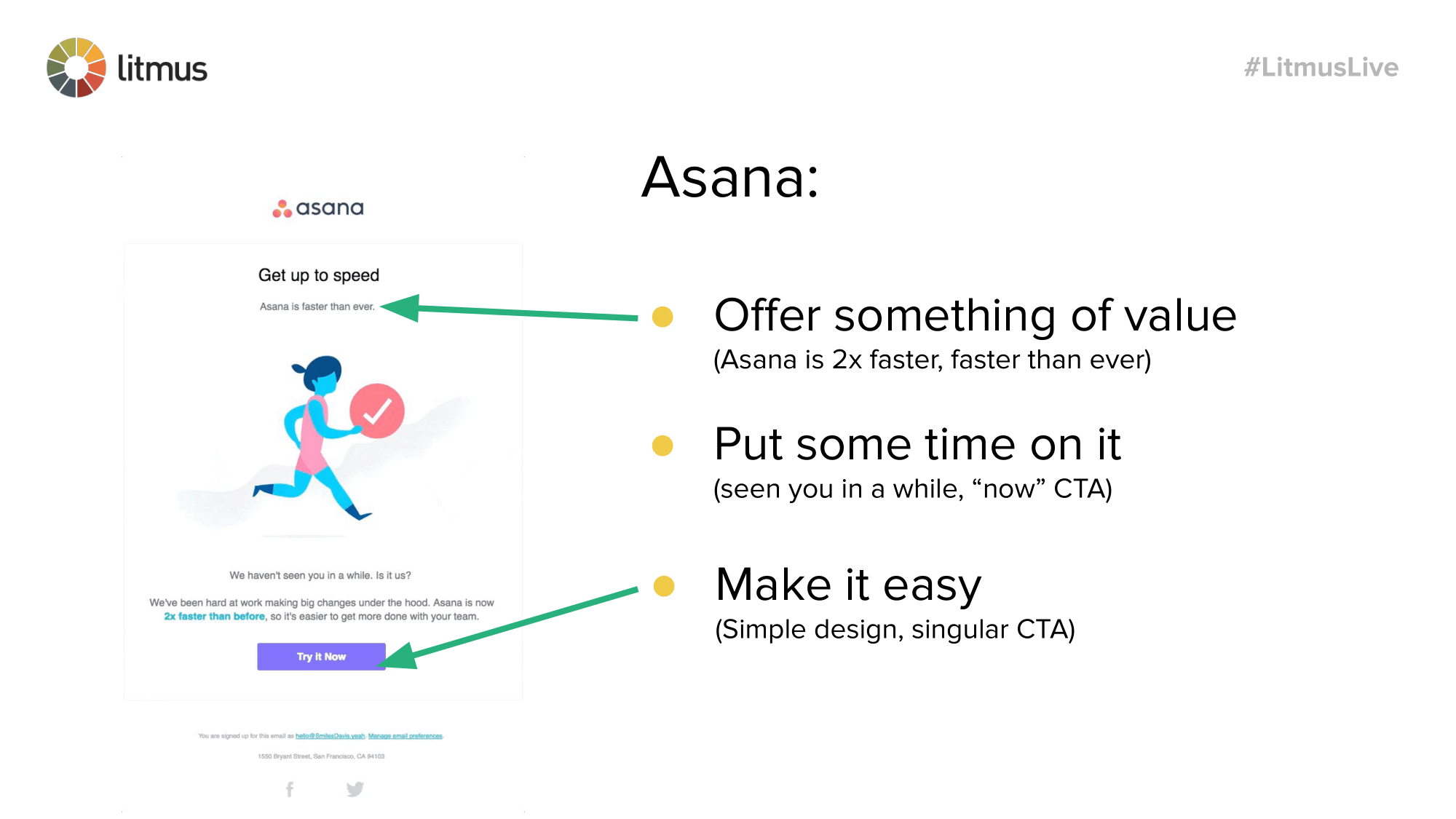
It just says the Asana is faster. Cool. Then a clear, easy CTA to give it a try. My only thoughts in this email and I might've missed this, but Asana was never slow for me. I've been a really happy Asana user for many years. So I'm probably not the target audience, which is why I might be confused, but it did remind me of a good point.
If you're going to use a product launch or an improvement, to get folks back, make sure you're telling the right folks the right message. If they've given you feedback on that in the past, closing the loop with customers on feature requests or anything is also a good touchpoint, but making sure that you know who you're talking to and you're telling them the right thing.
As an example, recently at Litmus, a tool we use announced via email that they've fixed a bunch of bugs. That was kind of the only announcement in the email. A few folks on the team were like, what is this email about? This doesn't really tell me anything. Who cares about bugs? But for myself who uses the tool very often. It's actually a very buggy tool and that's kind of known. So for me, it was really important and it was actually a big deal. I think they could've maybe fixed some of the confusion by segmenting out those folks that didn't really use the platform regularly. Since they obviously don't know it's buggy and now they do know.
That's why one of my big things is all about segmentation. Right message, right time, right people. I've got one last little bit and then, I'll wrap it up here. I just want to make the note that you can't leave people hanging. You can't ghost.
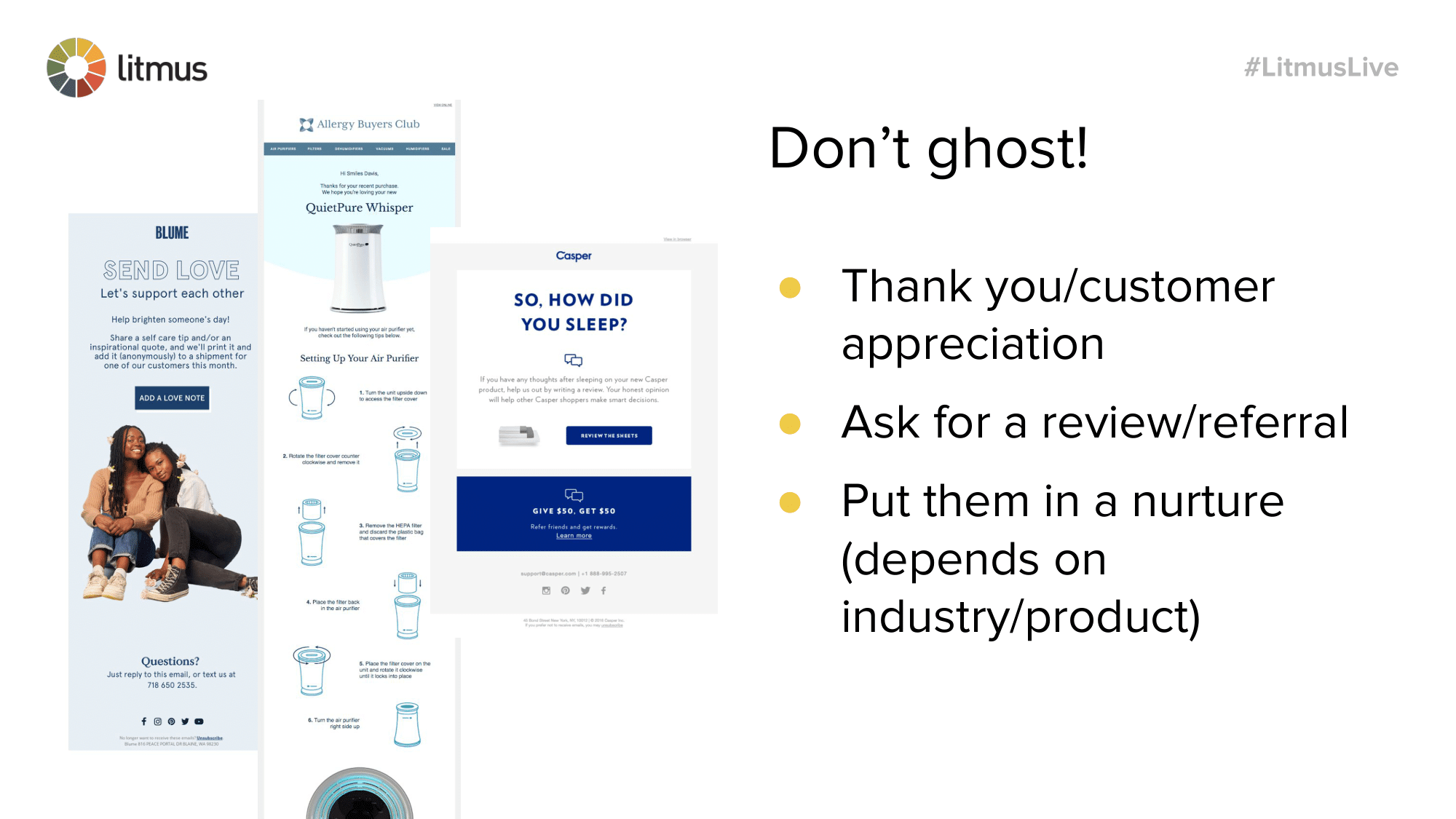
This is where that loop comes in that talks about, Don't leave people in that winback confirmation cycle. The not calling your parents and then them texting you to call them. Keep them in your thoughts and think about how you can bring them something valuable every once in a while so they also keep you in their thoughts.
It's about building that relationship and a relationship is a bit of a two-way street. So if they're giving you money, or contributing their time or whatever it is, for your product, it's definitely helpful, and meaningful to them if you give them something in return through your email program.
I've got a few other ideas on here... Discounts. Messy area, because then you can set the precedent that you're just going to give discounts forever to get people to come back. We were just talking about on our call before this, how we abandon carts on purpose sometimes to get the discount.

I bought a new house and I'm home shopping right now and I've definitely done some of those tactics. Be careful with discounts. It can really set a precedent that your product isn't worth as much as you're charging for it. It can get more and more difficult for you as you move forward, trying to get people back. They just expect the discount code and that's it.
It can be done. There are really creative ways to do it. Val's example was a great one. Free shipping is another good one that Mike brought up. I think that's it from me.
Jason Rodriguez: Awesome. So I definitely see some questions coming in, which I want to get to. Quickly just kind of remind people of some of these steps that you could take next to look at your own onboarding retention and winback campaigns.

When it comes to onboarding, I think for all of these categories, one of the key things you should do is review all of your emails on a fairly regular basis to make sure that you're setting the right expectations, that you're providing the value that you really need to provide your subscribers so that you can build that relationship in that longer-term relationship. For onboarding, make sure that your welcome emails are setting the right expectations. That you are doing that upfront work to reinforce your value proposition so that people know what they're getting into, what they can get from you as a company, and just give them the tools and the resources they need to kick that relationship off on the right foot.
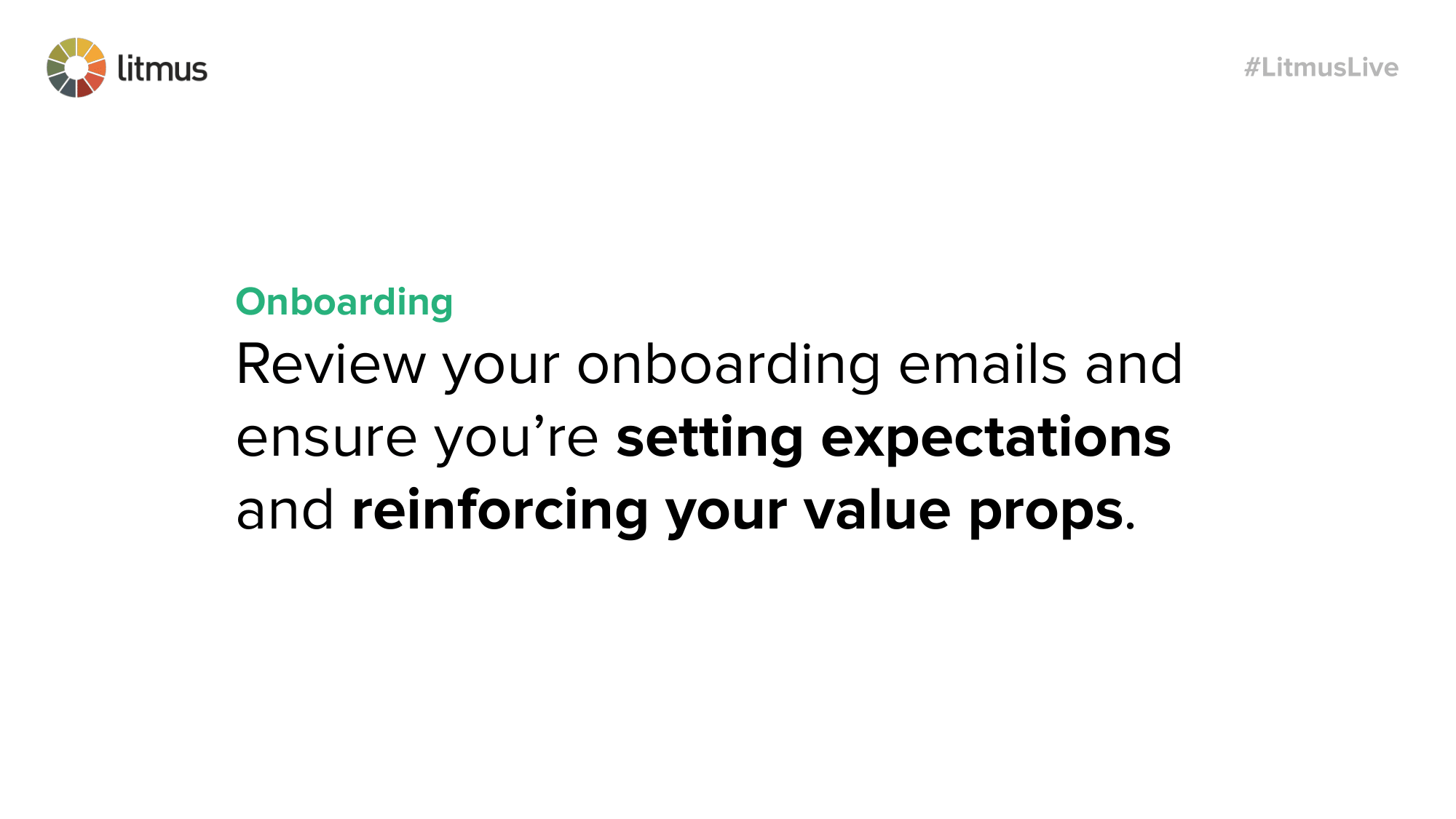
When it comes to retention, try to go beyond just buying it, reinforcing like, Oh, we can buy this thing and try to keep them engaged with your brand beyond just buying. I think Val had some great examples in there about using social stuff, creating these social campaigns, showing off what people have created with your product, or what they've accomplished with your brand. Just by reinforcing that kind of relationship and that loyalty between yourself and your customers long term beyond just trying to get them to buy things on a somewhat regular basis.

Finally, review those winback campaigns to make sure that you're offering something truly valuable, and they are really easy to take advantage of. I think Lyla had that great point that you don't just want to do that solely through discounts every single time. That does tend to set a bad precedent and you get a lot of people that are abandoning carts, just so they can get those discounts because they know that they're going to get 'em. So think about what other value you can offer you or your customers that have lapsed.

I do want to get into QA though. I know we're getting close on time here, but a couple of really good questions. One of them that's come through in a couple of different variations is with industries like travel, health care, higher education, things that are not specific like smaller products or something that people might buy on a more regular basis.
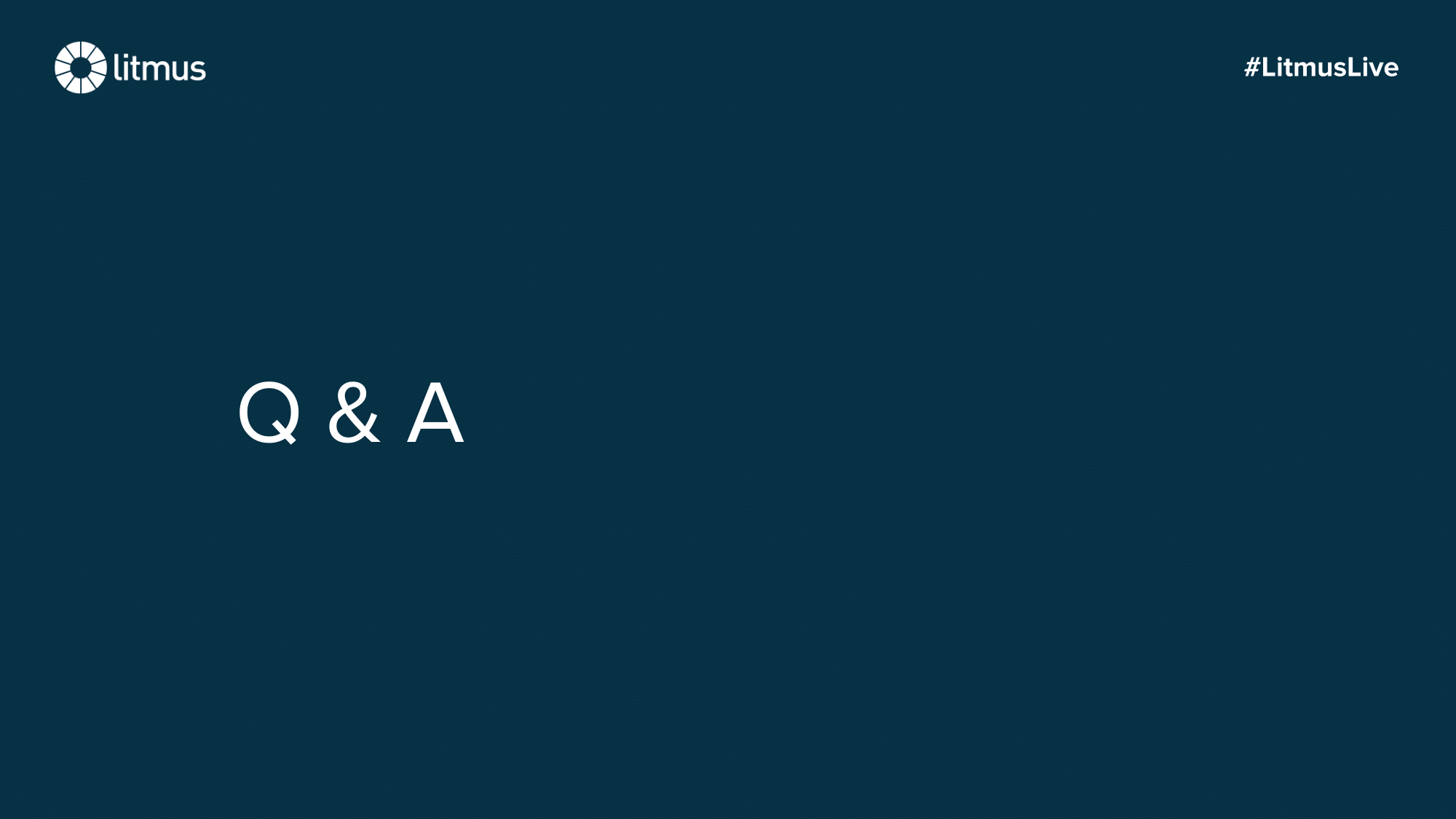
What do you three think about how you can tackle engagement longterm for those types of industries where it might be a year or more between those purchases? Because not everybody can afford to go on a big trip or in higher education it's more yearly as you get further on in your education.
So maybe Val, we could start with you about thinking about engagement, longterm, that retention for these longer life cycles for customers.
Val Geisler: Yeah. This is where I love telling customer stories. So whether it's the trip of a lifetime or the family trip before a parent deploys overseas, or those kinds of compelling stories that your customers have. Buying their teenager their first car. Those kinds of big purchases, there are stories that go along with them, and then you can use those stories to show that you care about your customers and that you're telling their stories. Sharing real pictures of them and using their names and reaching out to your other customers and sharing those stories.
These are also useful in that kind of pre-purchase. Where you can get people seeing themselves making this kind of purchase through someone else's story. It does also keep people seeing themselves in the future. Going on another vacation or buying another car for their kid that's going to turn 16 in three years.
Yes, there may be a long period, but there are lots of stories to tell. The more you can show your customers the different ways that they can see themselves living that same story, the better off you are in the long run.
It's also just about staying top of mind and you can use the stories to do that. We get so much information all the time that by showing up in their inbox regularly, keeps your brand top of mind when they think vacation or car or whatever that big purchase is.
Jason Rodriguez: Cool. I feel like, especially in healthcare, higher education, finance stuff like healthcare insurers. There are some insurers that are doing things well. Where you only buy insurance or opt into it once a year. So there is that longer cycle, but there's a lot of opportunities to remind people about how to stay healthy or what kind of checkups they can get and there's a lot of different touchpoints that you can do.
I get a sense that if you think about your industry, there's probably a lot more touchpoints you could take advantage of that most other competitors aren't doing, because people just don't spend the time investigating and thinking deeply about where they can do that.
Val Geisler: Yeah, absolutely.
Mike Nelson: This is really also a big point about just data collection in general and using that data for your benefit as a company. If you have an app or you have customer information that shows their behavior and their pattern of usage you can extrapolate, some of those data points to better inform your future emails.
So in the sense of like a car, or car insurance, I might have purchased something like a year ago, but now I've got something plugged in my car to show how many, how many miles I go per day, or how often I check into my car insurance. Maybe I got a ticket or something. I'm not saying I did, but maybe I did.
Those are different points to touch base with your users because you see them engaging the certain different points and that should infer that they're looking for information and you can take that information and benefit. So same with travel. I work pretty extensively in travel.
Just because somebody travels one big trip a year out of the US doesn't mean that they're not looking for one of those smaller weekend getaways that are closer to home. So what is their behavior like when they travel near versus when they travel far? Are you able to extrapolate some of that data based on their search behavior or things that they have looked at to see what's close to home? So there's definitely ways to look at the data. and benefit, your relationship in the sense of there are different types of people and at different times to reach each of those individuals.
Jason Rodriguez: Well, I think one of the questions that a lot of people have, and I know it's something that every email marketer struggles with is, how do you winback or how do you re-engage people that have unsubscribed for your emails? How do you get them back into your email program?
I'm just going to throw that out. Anybody who wants to tackle it have at it.
Mike Nelson: I'll go for it. So, this is where you really need to up your social game and your customer experience, because even if they've unsubscribed, they still may be purchasing from you or still be looking at you as a source of truth or information. Allowing them to opt back in is really important.
You should be using pop-ups on your website to again, push down that value proposition. There might be segmented email newsletters or journeys that they could opt-in for. I know Harvard Business review does stuff like this, or The Hustle has their own different, side thing that they do just for certain niches.
I subscribed for the entire thing, but now there's something I'm looking at. It's very specific to what I want. I only may want to learn about that for four or five emails long and I'll resubscribe to those very niche newsletter journeys.
Jason Rodriguez: Alright, so I have one more before we kind of wrap up here.
I'm seeing a couple of variations of this question too, but a perennial problem with email marketers and just anybody doing their job really is getting stakeholders and bosses to buy-in and support these initiatives.
So what are some techniques or what are some tactics people can use to get stakeholders to buy into investing in longer-term retention or better win-back campaigns, especially since a lot of times, those don't see the immediate value or immediate sales? Especially when I'm thinking about that long term retention.
Val Geisler: I got asked this a lot at the last Litmus Live. Like, okay, this is all great and I want to do it, but how did I get my boss to give me the time in the week to do it? My answer is that building these retention campaigns have value in marketing in multiple places. If for some reason they don't work out as email campaigns, these are now great pieces of marketing collateral for social campaigns. There's any number of use cases for these emails.
I always love to position it as, give me X amount of time, and so in long term retention, we're probably talking six months or I don't know that they're going to give you a year on it, but maybe. So say, give me six months, let's put these into place and see what happens and I'm willing to be wrong, but at least we'll know. We don't know if we don't try it.
On X date, I will deliver you the findings and we'll make a decision from there as to whether we keep going on this. I think just defining your parameters around how much time you're going to invest in creating these campaigns and then telling them exactly when you're going to report back on it and just say, again, that like willingness to be wrong.
Knowing that you probably won't be, but just putting that out there and saying I'm willing to abandon the project if, after X amount of time, we aren't seeing the results we want to see.
Jason Rodriguez: Cool. I know where I think we might have time for one more. How do you kind of balance all these email efforts?
We talked about email being first and that being your go-to channel, but then how do you take some of these learnings or balance this across different channels, like social media. So if you're investing all this time into retention campaigns or into winback campaigns, but you do have a really strong social media presence.
What does that balance look like? For brands to achieve that effectively?
Mike Nelson: I see these other channels as almost influences on your strategy. If you are doing something specific in a storefront or talking to people and it really resonates with them, I would add that into your onboarding process or a winback process to really reemphasize that value proposition that rings true.
Again, it's a testing environment on social. You can test different subject lines, different images, to see what people are engaging with. You can apply that over to email as well, or vice versa. You can find out what happens in email and go apply that to social media to grow your presence and see who else resonates with the value proposition that you already have with your current customers.
Jason Rodriguez: Cool. Good advice. So we're going to be wrapping up here, but did want to give everyone a couple of resources. Really Good Emails. Again, just they're known for collecting so many amazing email campaigns and just sharing them with the world, but they also do a really good job of categorizing things too.

So there are three categories in really good emails that are very pertinent to this discussion. So definitely check out the welcome, the engagement, and the winback categories.
Then be sure to check out a bunch of different resources, Litmus.com, especially on the blog, over at Litmus.com/blog. Val has fixemychurn.com and that dinner party strategy, which is amazing. I definitely recommend checking that out. I was actually looking at it the other day, cause it was so helpful. That's at fix my fixmychurn.com/tdps.
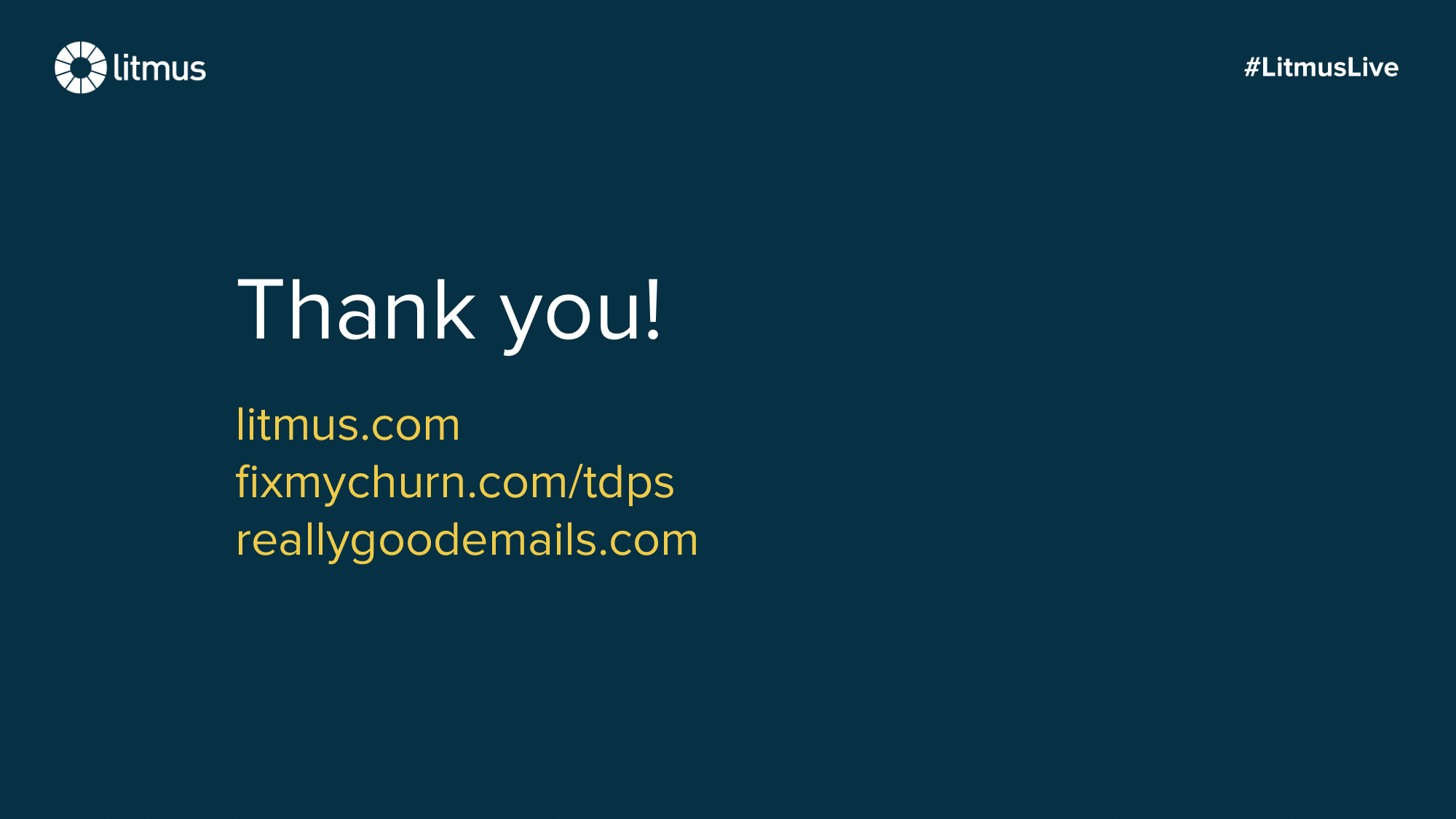
Then ReallyGoodEmails.com for sure, because they have so much inspiration, a bunch of resources, a bunch of articles, a great YouTube of email teardowns, and the kind of stuff to help everybody with these different phases of the subscriber journey.
So that's going to do it for us today, though. Thank you so much for joining us. I'm really happy that we got to talk through some of this stuff. And thank you so much, Val. Mike and Lyla for joining me today and we will definitely have all three of you back on to talk about some of these great email topics a little bit later.
Val Geisler: Thanks for having us.
Mike Nelson: Thanks y'all.
Lyla Rozelle: Thank you.
